

New and Enlarged Edition, Entirely Reset
With 33 full-page Illustrations, 12 in full color, and other drawings
in the text, and a Map of the Orient
CHICAGO A. C. McCLURG & CO. 1908[Pg i]
Copyright
A. C. McClurg & Co.
1901-1908
This Enlarged Edition published October 10, 1908
The University Press, Cambridge, U.S.A.[Pg ii]
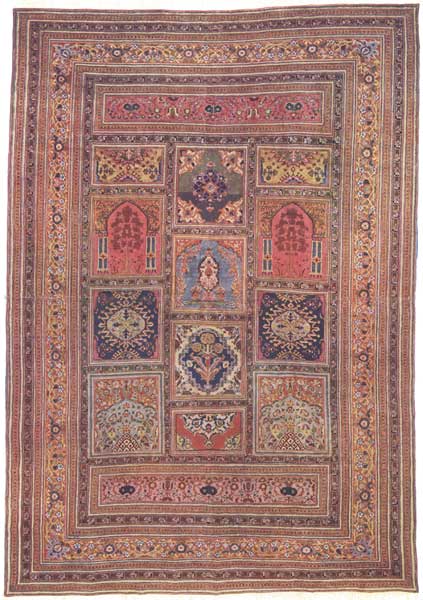 View larger image
View larger image
Size 8 × 6.3
This interesting and valuable rug is of antique Tabriz weave, of finely blended colors, and rare design. It represents the individual squares on the floor of a mosque, each one of which may be occupied by a worshipper kneeling in prayer. Rugs with a single design of this kind are usual, but a grouping of many such spaces in one rug is rare. Forms of the Tree of Life are represented in different panels, and the border is very rich and handsome. The fabric is fine, the texture soft and firm. The rich and splendid hues of the various panels are so soft in tone that, while there are several different colors in juxtaposition, these have been arranged so deftly and artistically that the effect is perfectly harmonious. It is impossible to describe in words the mellow richness and rare art displayed in this unique product of the loom.
TO NEW ENLARGED EDITION
When the first edition of this book was published in 1901, it stood almost alone as a reference work on Oriental Rugs. In the six years which have since elapsed, several volumes dealing with the subject have been published.
The extended knowledge of the public concerning the subject has materially altered the conditions of buying and selling. It has also served to increase curiosity and enthusiasm regarding these products of Oriental workmanship. I have been gratified to observe that a desire for additional information is sought. My mail has contained an increasing number of requests for an enlarged edition of my book, and my own enthusiasm for the subject makes me believe in the interest of my readers. I take pleasure in sharing with them the results of recent investigations made in the United States, in the art centres of Europe,[Pg iii] and in the Orient.
New York City,
February 1, 1908.
[Pg iv]
While there is a singular lack of books in the English language treating directly of Rugs,—a theme which is so intensely interesting to buyers,—it is noteworthy that under the category of Oriental Carpets are to be found a few volumes of interest. These, however, are too rare and expensive for the general reader. For this reason I have undertaken to present in a concise form certain facts that may enable a novice to appreciate the beauty and interest attaching to rugs, and assist a prospective purchaser in judging of the merits of any particular rug he may desire to possess.
For much valuable information on the subject I am indebted to publications which are referred to in my Bibliography, to correspondence with Ministers to Oriental countries and Consuls residing therein, to interviews with rug-dealers in various cities, and to certain learned Americans, Armenians, Greeks, Syrians and Turks. It has also been my good fortune to be intrusted, for purposes of description and reproduction, with many beautiful and rare rugs, from owners who cherish them as treasures. These true rug-lovers have generously contributed to[Pg v] whatever there may be of interest in this book.
New York City,
August 1, 1901.
[Pg vi]
| Page | |
| I. History and Details of Rug-weaving | |
|---|---|
| The History | 15 |
| The Loom and Its Work | 22 |
| The Weavers | 26 |
| The Materials | 30 |
| The Quality | 32 |
| The Knotting | 34 |
| Designs | 37 |
| The Dyes | 44 |
| Oriental Colors | 47 |
| II. Rug-Weaving in Egypt, Persia, and Turkey | |
| Rug-Weaving in Egypt | 51 |
| Persian Rugs | 53 |
| Characteristics of Certain Persian Rugs | 58 |
| Turkish Rugs | 71 |
| Characteristics of Certain Turkish Rugs | 74 |
| III. Rug-Weaving in India, Afghanistan, Beluchistan, | |
| Central Asia, and the Caucasus Region | |
| Indian Rugs | 87 |
| Characteristics of Certain Indian Rugs | 90 |
| Afghanistan Rugs | 95 |
| Beluchistan Rugs | 97 |
| Turkoman Rugs | 98 |
| Characteristics of Certain Turkoman Rugs | 100 |
| [Pg vii]Caucasian Rugs | 105 |
| IV. Miscellaneous Oriental Rugs | |
| Rugs of the Holy Land | 111 |
| Chinese Rugs | 113 |
| Japanese Rugs | 116 |
| Khilim Rugs | 117 |
| Polish Rugs | 119 |
| Prayer Rugs | 120 |
| Silk Rugs | 123 |
| Felt Rugs | 126 |
| Hunting Rugs | 128 |
| V. Rug-Weaving in Europe and the United States | |
| Rug-Weaving in Europe and the United States | 131 |
| Greek Rugs | 132 |
| Moorish and Spanish Rugs | 134 |
| Bosnian, Servian, Roumanian, and Bulgarian | |
| Rugs | 136 |
| English Rugs | 138 |
| French Rugs | 141 |
| Rugs of the United States | 143 |
| VI. Miscellaneous Information | |
| Inscriptions on Rugs | 153 |
| Concerning Oriental Symbols | 156 |
| Chinese Symbols | 157 |
| Egyptian Symbols | 158 |
| Indian Symbols | 159 |
| Japanese Symbols | 160 |
| Persian Symbols | 160 |
| Turkish Symbols | 160 |
| Miscellaneous Symbols | 161 |
| Meanings of Some of the Place-Names Associated with Rugs | 162 |
| Geographical Data | 164 |
| Localities Arranged Geographically | 165 |
| Localities Arranged Alphabetically | 170 |
| List of Authorities | 175 |
| Index | 179 |
| Page | |
| Antique Tabriz Silk Rug | Frontispiece |
| Oriental Rugs Decorating a Balcony | 20 |
| Turkish Loom and Weavers | 24 |
| Vats for Washing and Dyeing Wool—Turkey | 28 |
| Soumak Rug | 30 |
| Indian Rug Designers | 32 |
| Sinna Rug | 34 |
| Rugs being Transported | 38 |
| Wool Drying after Dyeing | 44 |
| Antique Persian Rug | 54 |
| Khorassan Rug | 56 |
| Bijar (Sarakhs) Rug | 58 |
| Camel's Hair Rug from Hamadan | 60 |
| Feraghan Rug | 62 |
| Shiraz Rug | 68 |
| Arabian Rug | 70 |
| Old Ghiordes Prayer Rug | 74 |
| Indian Prayer Rug | 78 |
| Indian Loom and Weavers | 82 |
| Afghanistan Rug | 95 |
| Tekké-Turkoman or "Bokhara" Rug | 98 |
| Samarkand Rug | 102 |
| Daghestan Rug | 106 |
| Kazak Rug | 108 |
| Antique Chinese Wool Rug | 114 |
| Khilim Rug | 117 |
| Old Kirman Prayer Rug | 120 |
| Old Anatolian Prayer Rug | 122 |
| Persian Silk Rug | 124 |
| Derbent Rug | 126 |
| Early English Rug | 138 |
| Navajo Rug | 146 |
| Antique Persian Rug | 156 |
| Map of the Orient | 164 |
| Drawings in the Text | |
|---|---|
| A Loom | 25 |
| Persian or Sinna Knotting | 35 |
| Turkish or Ghiordes Knotting | 35 |
| Soumak Weave | 35 |
| Five Forms of the Palmette | 39, 40 |
| Herati Border | 40 |
| Central Design | 41 |
| Running Hook Design | 41 |
| Pomegranate | 41 |
| Palm Leaves | 41 |
| Cloud Bands | 41 |
| Lozenge | 41 |
| Wave-like Designs | 42 |
| Rosette | 42 |
| Reciprocal Trefoil | 42 |
| Central Design | 42 |
| Four Characteristic Caucasian Designs | 42 |
| Fylfot, or Swastika | 42 |
| Guli Hinnai | 43 |
| Lotus | 43 |
| Medallion | 43 |
Fair warp and fitting woof
Weave a web that bideth proof.
Motto of the Canterbury Weavers.
Rugs, in the house beautiful, impart richness and represent refinement. Their manufacture was one of the earliest incentives for the blending of colors in such harmony as to please the eye and satisfy the mind; consequently, it is one of the most important of the industrial arts. Since the days when ancient peoples first lay down to sleep wrapped in the skins of animals, the human intelligence has quickened, and as the race has become more civilized, rugs have gradually taken the place of skins. Thus began the industry of rug-weaving, and it has grown to such an extent that it is now of world-wide importance.
The word Rug is used in this volume in the following sense: "A covering for the floor; a mat, usually oblong or square, and woven in one piece. Rugs, especially[Pg 16] those of Oriental make, often show rich designs and elaborate workmanship, and are hence sometimes used for hangings," In several books rugs and carpets are referred to as identical. In fact most written information on rugs has been catalogued under the term carpets; and there seems to be good reason for assuming that the terms tapestries and carpets, as used in ancient times, were synonymous with the word rugs of the present day, for these were spread loosely on the floor without the aid of fastenings.
Historical references to spinning and to the weaving of tapestries date back to a very early period. An ancient Jewish legend states that Naamah, daughter of Lamech and sister of Tubal-Cain, was the inventor of the spinning of wool and of the weaving of thread into cloth.
On at least two of the wonderful rock-cut tombs at Beni-Hassan, in Egypt,—2800-2600 B.C.,—there are pictures of weavers at work. In one, women are filling a distaff with cotton, twisting it with a spindle into thread, and weaving this on an upright loom. Beside them is a man, evidently an overseer, watching the weavers and their work. The other wall-painting represents a man weaving a checkered rug on a horizontal loom. Other monuments of ancient Egypt and of Mesopotamia bear witness that the manufacture of rugs dates a considerable time prior to 2400 B.C.[Pg 17]
At Thebes a fresco, dating 1700-1000 B.C., represents three men weaving at an upright loom. A small rug, discovered in that city some time between the years 666 and 358 B.C., and now in the possession of Mr. Hay in England, is described by Sir J. Gardner Wilkinson as follows: "This rug is eleven inches long by nine broad. It is made like many carpets of the present day, with woollen threads on linen string. In the centre is the figure of a boy in white, with a goose above it, the hieroglyphic of 'child' upon a green ground, around which is a border composed of red, white, and blue lines. The remainder is yellow, with four white figures above and below, and one at each side, with blue outlines and red ornaments; and the outer border is made up of red, white, and blue lines, with a fancy device projecting from it, with a triangular summit, which extends entirely round the edge of the rug. Its date is uncertain, but from the child, the combination of the colors, and ornamental border, I am inclined to think it really Egyptian, not of the Pharaonic, but of the Greek and Roman period." Dr. Samuel Birch, who edited the last edition of Wilkinson's work, affirms that this is so.
On the marbles of Nineveh is represented the pectoral worn by Sardanapalus. It is an exact miniature of a Kurdish rug of modern times. The Tree of Life, the motif of most of the Persian rug designs,[Pg 18] is in the centre, and the border is ornamented with rosettes and bars.
Phœnician art is intermediate between Egyptian and Assyrian. The color most prized in the art of Phoenicia was the rare and beautiful purple (properly crimson) dye used exclusively for the garments of royalty. For centuries the process of making this dye was lost, and even at the time of its highest fame it was familiar only to the maritime Canaanites, who procured the color from an animal juice of the murex, a shellfish. The shellfish and the dye were known to the ancients as conchylium.
When Cleopatra, the famous Queen of Egypt, went to meet Cæsar for the first time, she knew that he would not allow her to enter his presence if recognized, and therefore she cleverly had herself carried into his palace wrapped in a rug of the finest texture. It may well be imagined that the unexpected disclosure of the charms of this subtle Egyptian shared largely in bringing the great Roman general into her toils.
Besides Biblical writers, Homer, Æschylus, Plautus, Metellus Scipio, Horace, Pliny, Lucan, Josephus, Arrian, and Athenæus all speak of rugs. To persons interested in rugs the search for these allusions is a most fascinating occupation.
The Egyptians bestowed the greatest care and patience upon the rugs they wove, as upon all else of their[Pg 19] handiwork. They spread them before the images of their gods, and also on the ground for their sacred cattle to lie upon. They loved Nature intensely; like true lovers, they seemed to have reached her very heart, and they symbolized her works in their artistic designs. Even to this day many Oriental rugs have symbolic signs borrowed from the works of Nature.
In design and color the rugs woven to-day in the Orient are similar to the Assyrian and Babylonian textile fabrics of 1000-607 B.C. (Fall of Nineveh) and 538 (Fall of Babylon). At that early period these were used for awnings and floor-coverings in the palaces of the Assyrian kings Sargon, Sennacherib, Esarhaddon, and Sardanapalus. The designs on the stone slab from the palace of Koyunjik, Nineveh, and on the door-sill from the palace at Khorsabad, are probably copied from rugs.
From Egypt and Chaldea the manufacture of rugs was carried into Assyria, and then into Asia Minor. Ancient Egypto-Chaldean designs are occasionally seen in modern rugs, but usually in a modified form. For a long time the industry of rug-weaving was supreme in the countries mentioned, but about 480 B.C. it arrived at a high degree of perfection in Greece. Later, the art was corrupted by the Byzantine (Lower Roman) influence. In the seventh and eighth centuries the Saracens came into power in the Persian Empire after the fall[Pg 20] of the Sassanian dynasty, and in the African and Syrian provinces. The Saracens believed that all labor tended to the glory of God; consequently, on their western campaigns they carried rug-manufacture into Sicily, Spain, France, and Italy; and thus it was introduced throughout Europe. It should be here noted that the name Saracen was given by the later Romans and Greeks to certain of the nomadic tribes on the Syrian borders of the Roman Empire. After the introduction of Mohammedanism the name was applied to the Arab followers of Mohammed.
From earliest times it has been the custom in the East to hang rugs over graves. About the vault of the mosque at Hebron where the patriarchs Abraham, Isaac, and Jacob are said to be buried, rugs are hung at the present day.
During times of grand fêtes in Europe, when house decoration is done with lavishness, people, to make their homes more attractive, drape with beautiful rugs the balconies, the loggias, and the front walls of buildings. The richness and color of these rugs blend harmoniously with flags and other emblems, producing an effect of great magnificence and splendor.
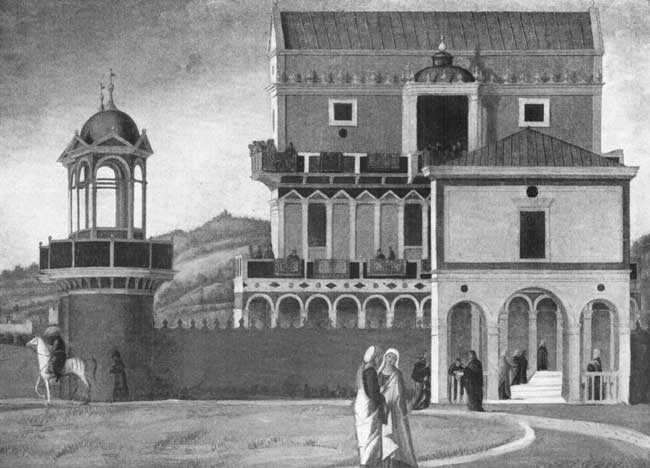 ORIENTAL RUGS DECORATING A BALCONY
ORIENTAL RUGS DECORATING A BALCONYWhen we see the exquisite loom-work that has been wrought in the Orient, we sometimes wonder how the weavers have achieved such success, for they are destitute[Pg 21] of what we call education, and they dwell amid the humblest surroundings. But Nature has been their instructor, and the rare shadings and varied designs of the rugs are excellent imitations of the forms and hues of the natural world. The weavers have intuitively grasped what is correct in color from the works of Nature surrounding them, and we reap the benefit in the rich specimens of their art which they export.
These patient toilers of the East delight in subdued colorings and artistic designs; and without a doubt many a story is woven in with the threads that go to form the fabric, many a song of joy, many a dirge of woe and despair. The number of Orientals engaged in the manufacture of rugs in the United States is increasing. It is now not an uncommon sight to see these weavers at work before the loom in the show windows of the rug-importing establishments of the larger cities.
The increasing use of polished hard wood and yellow pine floors and mosaic work, even in buildings of moderate cost, is displacing the use of cheap flooring, which could be covered satisfactorily only with carpets or matting. This has enormously increased the demand for rugs; and the selection of them affords a much wider range for the exercise of personal taste and discrimination in securing an article not only of greater artistic merit, but of greater durability.[Pg 22]
The hand loom is Oriental, the power loom Occidental. The former adds much to the fame of the Orient. The exquisite fabrics it produces have made it world-renowned, and although it is simple in structure, its products show careful and finished labor. Hand looms in all Oriental countries are similar, and are to-day almost as imperfectly developed as when used by the ancient Egyptians. To weave their mats, the ancient Egyptians took the coarse fibre of the papyrus and, with the help of pegs, stretched it between two poles which were fastened in the ground. Two bars were placed in between these poles, the threads of the warp serving to keep them apart. The woof thread was passed through and pressed down tightly a number of times with a bent piece of wood.
The loom now generally used in the Orient is made by fastening two poles perpendicularly in the ground to a sufficient depth, leaving above ground as much of each pole as equals in length the desired rug. This framework supports two horizontal rollers, the warp threads being wound around the upper, while the ends are fastened to the lower; at this the weaving is begun,[Pg 23] and on it the rug is rolled while in process of construction. To the warp threads of fine linen or cotton the weavers tie the tufts of worsted that form the pile. This worsted, which has been dyed previously, hangs over their heads in balls. When a row of knots is finished, it is pressed down to the underlying woof by a long and heavy comb with metal teeth. Then the tufts are clipped close with shears, to make the pile. In the finer rugs there are seldom more than two, or at the most three, threads between every two rows of knots, but in the coarser kinds there are more threads. In many districts every family possesses a loom, and it is generally small enough to be carried from place to place.
Sir George C. Birdwood has seen the web in the horizontal loom in Western India kept stretched by being wrapped, as worked, round the body of the weaver. In some instances the spinners make thread from the cotton wool by using the left hand as a distaff, and the right one as a spindle. In other cotton rugs which he has seen, the warp threads were placed horizontally, and the loom was without treadles and reed. The woof threads were thrown across by the weaver and brought together with a small hand comb. The same style of loom, arranged vertically, is that on which some of the richly figured cotton rugs from the Deccan are woven.[Pg 24]
In some parts of Turkey there are European factories that have adopted some of the native methods; but as the majority of Turkish rugs are apt to be crooked, frames that weave them straight are now imported from Europe.
Mrs. Isabella Bird Bishop describes a tribe of people living at Biratori, on the Island of Yezo, Japan, and bearing the name of Ainos, whose women employ their time in weaving mats. Their loom is certainly a most primitive arrangement. A comb-like frame, through which the threads pass, rests on the ankles of the weaver. There is a heavy hook fastened in the ground or floor, and to this the threads at the far end of the web are sewed. A cord fastens the near end to the waist of the weaver, who by spinal rigidity supplies the necessary tension. As the work proceeds, she drags herself along nearer and nearer the hook. This is slow work, only about a foot being accomplished in a day; as in other countries, however, the women enjoy the neighborly chats that their work allows; and often two or more will bring to the house of a neighbor their simple apparatus, and, hanging the hooks to the roof or to a tree, will weave all day.
The power looms of modern civilization are chiefly to be found in the United States and Great Britain, Philadelphia being the principal American centre, and Kidderminster, Wilton, Worcester, Rochdale, Halifax, Dewsbury, and Durham, the English centres. Brussels[Pg 25] and Scotland contain a number of such looms. In all Western countries schools of art furnish most of the designs, and have done much to improve taste. This can also be said of good colorists in their branch of this industry.
Rug-weaving in the Orient is an industry that, until recent years, has been carried on almost exclusively by women and girls. From childhood to womanhood, and on to old age, these weavers are at work. Girls of six years of age help their mothers, until they become experienced by long practice. Even ladies of rank and wealth weave rugs of fine quality for their own homes. In some districts, besides weaving for the market, girls weave one or two rugs for their dowry; this purpose furnishes them with enough excitement to keep them interested in their work and ambitious to excel. Now that there is a greater demand for rugs, and not enough women to supply the demand, men and boys have come into the business, but generally only in places where there are large factories, and especially in the cities. This is noticeably the case in India, where boys from nine to fifteen years of age do much of the weaving.
There are two classes of weavers, the sedentary and the nomadic. The former weave in their houses during the Winter, and in their courtyards during the Summer. The nomads spend the Winter in mud villages, and in the Summer go to the mountains with their flocks and[Pg 27] live in tents made of goat's hair. The manner of life of the sedentary weaver works havoc with her constitution even in her youth; and consequently one is not surprised at her frail appearance. In Summer she is oppressed with heat as she sits before the frame, and in Winter she is almost frozen, for she has to work in the open air in order to have sufficient light. Hers is not an easy life. It would be pleasant to believe that in her toil, which she carries on with wondrous patience and in the humblest surroundings, the conscientious weaver finds the same inward satisfaction that comes to the true artist elsewhere.
The duties of the male portion of the family are to tend the flocks, shear the sheep, separate the various qualities of the wool into bundles, dye it, and make the framework for the rug. With the extension of the industry, a class of workers has arisen whose sole task is to manipulate and dye the wool for use. The reason why men do not usually weave is that the occupation, besides not being a paying one, requires an amount of patience not within the power of men accustomed to work out of doors. Nor is it a remunerative occupation. The reader, who is perhaps also a prospective rug-buyer, may be interested in the following calculation of the amount of labor bestowed upon a given piece of the best type, the cost of the materials, and its value when[Pg 28] completed. A square foot of the best Persian rug is worth about ten dollars, and it takes a single weaver twenty-three days to complete this portion. This allows the weaver about forty-four cents per day for her wool and her labor; but as three-fourths of this amount goes to pay for the wool, only eleven cents per day is left for her labor. The wages of the producer of the inferior article are somewhat better. A square foot of an inferior rug is sold for about sixty cents, and the time required for weaving it is but two days, thus allowing the weaver thirty cents per day for her wool and labor. She uses inferior wool, washes but little of it, and pays only a nominal sum for a cheap dye. The framework of her loom costs comparatively little, as the rug it produces is from twenty to thirty times the size of the superior rug. Thus it appears that, in the long run, the inferior weaver is better paid than the one who fatigues her brain with her efforts to produce a rug of the best quality. On the other hand, the weaver of the superior fabric has advantages which the other has not. As a general rule, she weaves to order, and is paid for her work in advance. This prepayment is of great importance, considering the poverty of the weaver. The situation of the weaver of the inferior article differs in that she has to buy her wool, dye it, finish her rug, and then watch the market for buyers.
The weavers live on the simplest fare; bread, cheese, and a raw onion make an average meal. In some districts the weavers have to work in underground huts, for the air at the surface is so dry that the threads would lose all their elasticity out of doors. In these underground places the weavers produce enough moisture by keeping at hand utensils full of water.
Although the business is conducted with the manufacturer on a strictly commercial basis, it is very difficult to induce the weavers to keep their appointments and finish a rug at the time it is promised. In India, for example, the weavers are very superstitious; and if a boy weaver be taken ill, the entire force on that loom will stop until he recover. If he die, the entire force of native weavers may be changed. This of course causes vexatious delay, not only of days, but often of weeks and months.[Pg 30]
The materials used in the manufacture of rugs cover a wide range, and are indigenous to the place where the weavers are located. Sheep's wool, camel's hair, mohair from the Angora goat, hair from the yak and from the Thibetan goat, silk, cotton, linen, hemp, flax, and jute are all used. In the Spring the raw wool is generally taken to the nearest market, where it is cleaned, washed, and spun. The cleansing process is very necessary, as it affects in an important degree the quality of the material. The wool is usually washed in running water by the men, and then sorted and cleansed a second time.
Persia, Turkey, and India all produce wool, the two former countries in larger quantities than India, but some of the very finest wool comes from that part of India known as Kashmir. The celebrated Turfani wool comes from Chinese Thibet. It is very choice, and beautiful fabrics are woven from it.
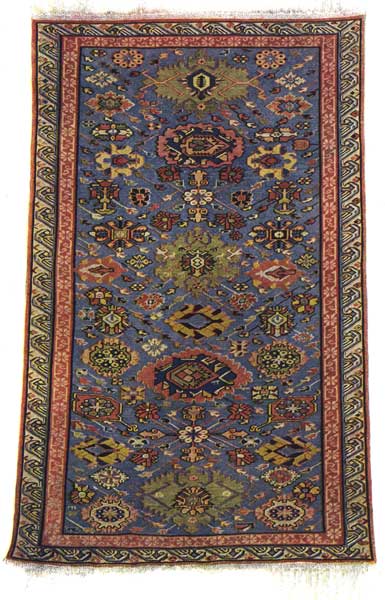
Size, 4.11 × 3.1
The fine weaving of this Soumak Rug and its beautiful coloring are especially admirable. The texture is very firm, the threads being tightly drawn. On a field, which is a choice shade of blue, rest geometrical forms, each one of which has a ground of terra cotta, pale green, or soft yellow, and is ornamented with rich blue, ivory, or a light shade of terra cotta. All are outlined with black. The hook design is noticed in different parts of the rug, and especially in the border. The artistic effect of this bit of weaving is most pleasing.
View larger imageThe pashim is the soft downy wool growing next the body of the goat. In color it is white, dark gray, or drab; and of this many of the finest India rugs are woven. Large-tailed sheep are common in Kabul, Peshawar, and other districts; these furnish wool from which[Pg 31] many a rug is woven. It is possible that the very sheep watched over by the shepherds of Judea the night of our Saviour's birth were reared partly for their wool, with a view to rug-weaving.
The camel is useful not only as a beast of burden; its hair is woven into fabrics both fine and durable, chief of which are rugs, beautiful, much desired, and costly; the younger the animal the more is its hair esteemed. The natural colors harmonize readily with the furnishings in most rooms, and the soft texture of the best ones is attractive.
The process of carding is accomplished by means of a block with vertical pins in even rows close together. The wool is drawn through these many times, and then spun into yarn.[Pg 32]
The fineness of a rug depends largely upon the quality of the wool and the number of knots to the square foot. In one yard of the best made Persian rugs there are between twenty thousand and thirty thousand stitches made by hand. The wool must be of fine quality, but not too soft. It should be closely woven, and evenly cropped. A great deal depends upon the manipulation of the wool in the rough, and careful attention should be given to this particular.
The quality of the wool is affected by whatever circumstances affect the well-being of the sheep, and in a marked degree by climate. Hence there is a decided difference in the wools of various districts and sections of a country. It is a well-known fact that the wool produced in cold countries is soft and fine, while that of the warmer climates is, on the other hand, harder, firmer, and more lasting. Hard wool is easier for the weaver to handle, and the tufts can be cropped with more facility. It is partly owing to these facts that the rugs of the cold districts are most in demand.
The fact that some rugs are so much better than others is a natural result of the superior skill of the[Pg 33] makers. Weavers are like other workers, some doing perfect work, some indifferent, and others very poor. But the quality of the rugs offered for sale in this country depends also upon the knowledge and the conscience of the wholesale buyer at the place of manufacture. When the buyer for an importing establishment brings over quantities of rugs not all of which are artistic, the question may be asked: "Why do you not always select rugs that are beautiful?" He may reply that it is his business to get those that will sell, and that as there is a great variety of taste among his customers he must try to please every one; or he may say that he buys a thousand rugs at a time, and does not see them individually. It is in the retail shop that the final purchaser may pick and choose.
The most famous rugs of the Orient have been selected with great care by men who have special knowledge of the subject, and they are owned by museums and connoisseurs. Some have been brought to this country by distinguished soldiers and statesmen, to whom they have been presented by potentates as tokens of respect. Others have been obtained through the fortunes of war.[Pg 34]
Except in the Soumak and the Khilim, which have the flat stitch, there are only two kinds of knotting used in Oriental rugs. These knots are called the Persian or Sinna, and the Turkish or Ghiordes.
In the Persian manner of knotting there are more knots to the square inch than in the Turkish, and the result is a finer surface. Often the Persian knotting is so fine that the surface of the fabric is like velvet. The Persian knot is tied in such a manner that one end of the pile yarn extends from every spacing that separates the warp threads. It is made in such a way that a noose is formed, which tightens as the yarn is pulled. Occasionally it is turned in the opposite direction, and executed from left to right. In this case two threads of yarn are employed, this of course making the pile twice as thick as in the other.
The Turkish or Ghiordes knot has the yarn twisted about the warp threads in such a manner that the two raised ends of the pile alternate with every two threads of the warp.
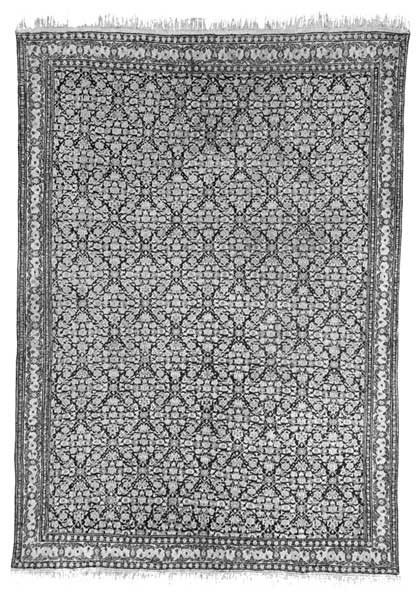
Size, 4.6 × 6.6
This is a beautiful example of the very fine texture and the even clipping that characterize the Sinna rugs. Thickly studding the dark blue field are minute designs in blue and rose hues, with which pale green, yellow, and a sapphire blue blend most harmoniously. All these small designs rest in the usual diaper design, which may be traced throughout the rug. The border is charming, with its groundwork of fine yellow, on which are delicate tracings of light green, ivory, and blue. The effect of light and shade upon this exquisite piece of weaving brings out plainly the marvellous sheen which is a feature of this rug. The innumerable small figures which appear throughout the rug, with their blending of soft hues, present a kaleidoscopic effect.
View larger image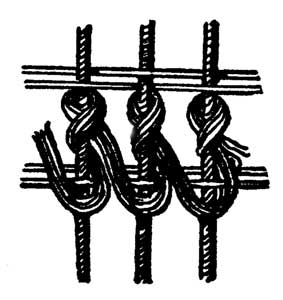 Persian or Sinna Knotting
Persian or Sinna Knotting
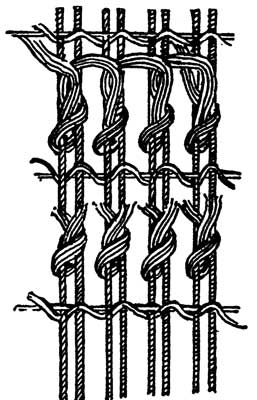 Turkish or Ghiordes Knotting
Turkish or Ghiordes Knotting
Experts have spent much time and invested much capital in the endeavor to make the rug industry as[Pg 35] perfect as possible. Judging from the examples of India rugs I have seen,—some with a seven-by-six knot, others with a sixteen-by-sixteen knot,—I am convinced that the beauty, durability, and artistic effects produced by the efforts of the manufacturers will be appreciated more and more. From the fact that the best-known firms in the rug business in New York, Chicago, and other cities in the United States, and several leading firms in England, are sponsors for the present rug industry in India, it may naturally be inferred that it is prosecuted with skill and care.
The different stitches made are as follows: seven by eight, or fifty-six hand-tied knots to the square inch; eight by eight, or sixty-four knots to the square inch; ten by ten, or one hundred knots to the square inch; twelve[Pg 36] by twelve, or one hundred and forty-four knots to the square inch; and sixteen by sixteen, or two hundred and fifty-six knots to the square inch. These finer stitches are made in the very best examples produced by the finest Persian weavers. A specimen recently shown me was an exact reproduction of the rug owned by Prince Alexis Lobanow-Rostowsky, in which the stitch was the sixteen by sixteen. It was made in one of the factories in Kashmir.
The famous rug of Ardebil in the South Kensington Museum has three hundred and eighty hand-tied knots to the square inch, or thirty-three million in the whole fabric.[Pg 37]
The designs of Eastern rugs are often the spontaneous outcome of the fancy of the weaver. Sometimes they are handed down from one generation to another; in some cases young girls are taught the design by an adult, who marks it in the sand; at other times a drawing of the rug is made on paper, the instructor showing her pupils the arrangement of every thread and the color to be used. When all this has been done, the pupil must make the rug without looking at the drawing.
Persian rugs excel those of other countries in artistic design as well as in harmonious coloring. The Persians seem to have a natural intuition in the use and blending of different shades, and in the designs that contain these colors they achieve the happiest results. It is really wonderful what exquisite fabrics these people, born and reared in ignorance and poverty, produce.
The designs in Persian rugs are generally floral; and in some districts, especially Fars, the women weavers invent the designs, varying them every two or three years. The Mohammedan religion does not allow any direct representation of animal forms; consequently rugs woven under its influence take floral, geometric, and[Pg 38] vegetable forms. The Shiah sect of Moslems, however, numbering about fifteen millions,—of which eight millions are Persians,—do not regard representations of animals as unlawful. By the industry of this sect, and that of all who disregard the law of the Koran, animal forms are seen on some Persian rugs.
Among the good antique Persian rugs there are about thirty designs, all having different borders. Each design is the peculiar work of a family or tribe, and is produced continuously, from generation to generation without noticeable change, except in compliance with the demand of a buyer, or by a weaver who carries out some special fancy. Many buyers select the color, design, and size, leaving their orders with an importer or a manufacturer.
In the modern Oriental rug the designs are not to be entirely depended upon. They are apt to vary at the will of the weaver; and moreover, Occidental designs are now sent to the Orient to be woven into rugs by the native weavers of the Eastern country. The designs sent to India, to be reproduced by the different European and American firms having factories there, are almost universally strictly Oriental in character, being copies from fine old Persian pieces, or rearrangements of Oriental forms. When the design reaches India, it has to be re-drawn to the exact size of[Pg 39] the rug that is to be made. From this is copied what is called a talim, which is the only direction the weavers have. This talim, or guide, shows the weavers exactly how many knots of a color are to be tied; and when these different colors are put together, the design is formed. These talims are carefully kept, and as they are records of the designs, can be reproduced at any time.
Large rugs show best in large and bold designs, for small and crowded designs would not be artistic. Small designs are, however, preferable on small rugs; a bold design on a small rug is inappropriate. The finer the border of a rug of whatever size, the more beautiful and costly the rug.
An average size for a large rug is six yards by four, and for this a bold vigorous design would be suitable.
Some designs found in rugs are here reproduced.
I. Five Forms of the Palmette.
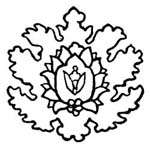 |
a. With sharply marked outlines this palmette is a characteristic of the Djushaghan rugs. |
 |
b. This is a geometrical form of the palmette, frequently met with in modern Caucasian rugs. |
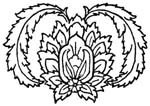 |
c. This form of the palmette has an oblong central nucleus, surrounded by wreaths of leaves. To the right and left lancet-shaped leaves nearly encircle the whole. This design is most frequently seen in old Persian rugs.[Pg 40] |
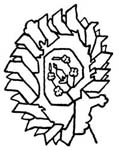 |
d. In some old Persian rugs this form of the palmette with its diagonal projections is seen. It tends toward the geometrical, although its centre contains a small floral spray. |
 |
e. This palmette, with its two flanking lancet-shaped leaves, is frequently seen in modern Feraghan and Kurdistan rugs. |
 |
II. The Herati Border, or some form of it, may often be seen in Herat, Feraghan, Khorassan, Kurdistan, and Sinna rugs. |
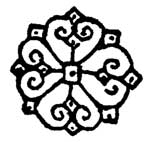 |
III. The central design is formed by eight valvular or four heart-shaped leaves. This form is often seen in Kirmanshah and Shiraz, and sometimes in Caucasian rugs. |
 |
IV. The Running Hook design found in the Daghestan, Shirvan, and Soumak rugs. |
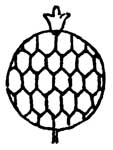 |
V. Pomegranate. The fruit is often depicted on ancient Assyrian and Egyptian sculptures. It had a religious significance in connection with several Oriental cults and was early introduced into rug designs. |
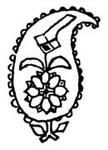 |
VI. A palm leaf with regular contour, its centre containing a small floral design. This form of design is found in more or less detail in the rugs of Persia and India. |
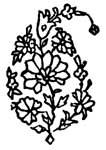 |
VII. A palm leaf formed by a floral branch and without distinct outline. |
 |
VIII. Cloud bands, seen in Chinese and old Ghiordes rugs. |
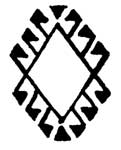 |
IX. A lozenge surrounded by the Hook design. This is found in rugs made by nomadic tribes of Asia. |
 |
X. A continued wave-like design with rosettes attached. At intervals a delicate tendril effect is interposed on either side of the wave-line.[Pg 42] |
 |
XI. A continued wave-like design interrupted by a two-cleft figure. |
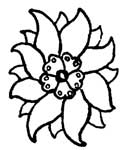 |
XII. A rosette, the tips of its leaves bending backward. The rosette is often met with in old Khorassan, Herat, Feraghan, and other Persian rugs. |
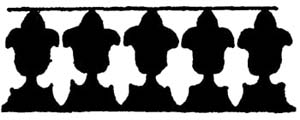 |
XIII. Reciprocal trefoil, or spade design. Found as a border design in many of the Caucasian and some Persian rugs, especially the Saraband. |
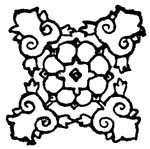 |
XIV. The central design holds a rosette, to which are joined four blossoms resting in valvular calyxes, the complete design forming a cross. |
 |
XV. Four designs characteristic of the Caucasian rug. |
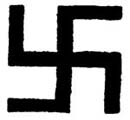 |
XVI. The Fylfot is in the form of a Greek cross with each arm continuing at right angles. It is also known as the Swastika, and is the symbol of good fortune. It has been a favorite design in[Pg 43] the rugs of Greece, and of the Orient, while it predominates in the Navajo rugs of the United States. |
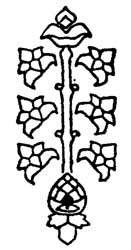 |
XVII. The Guli Hinnai is a decorative floral design found at its best in the old rugs of Feraghan. It is copied from the flowers which grow in small clusters on the henna-plant, from which it derives its name. |
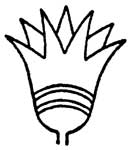 |
XVIII. The Lotus is the water lily of Egypt. In various forms it is found in antique rugs of Persia. |
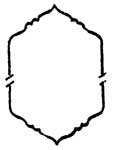 |
XIX. The Medallion, in both floral and geometrical designs, is seen in many rugs of all rug-weaving countries. |
There are many more designs which by careful investigation can be found. Among others the Arabesque, Chinese fret, Circle, Comb, various forms of the Cross, Mina Khani, Octagon, the S form, Scroll, Serrated leaves, Shah Abbas, the Star,—six or eight pointed,—the Tarantula, Triangle, the Y form, and the Zigzag.[Pg 44]
When doing their best work, Oriental weavers use the softest of permanent dyes. The result obtained is in every case a thing of beauty and utility. The aniline dyes are, of course, not to be compared to the vegetable, although the best of them are not to be utterly condemned. The poorest aniline dye eats into the rug, and the color fades.
Madder ranks high among those plants which yield a permanent dye. It belongs to the genus Rubia; the root employed is that of the Rubia tinctorum. This is largely cultivated in certain districts of India, but the best comes from near Smyrna, and from other parts of Asiatic Turkey. The plant grows wild throughout a large section of Central Asia and Russia. With both the European and the Indian madders the roots of the plants are the only parts that yield the dye. In the roots three coloring matters are obtained: alizarin and purpurin, which are both red, and xanthin, which is yellow. Cochineal was introduced for dyeing purposes in 1856. It is the product of an insect called Coccus cacti, which lives on a species of cactus. Yellow is often produced from Persian berries, turmeric, saffron, and sumac.[Pg 45]
Tyrian purple dye was greatly prized by the Phoenicians. As stated above, it was obtained from a shellfish; but the secret was known only to the maritime Canaanites. The art of producing this dye has been lost, although some aver that in recent years it has been re-discovered.
Kermes, red in color, is one of the oldest of all dyes. It was known in Syria, 1200 B.C. It is not so brilliant as cochineal, but it is much more durable. Plutarch is authority for the statement that after one hundred and ninety years stuffs dyed with kermes retained their original color. The dye is the product of the bodies of females of the species of coccus which infest certain trees along the Mediterranean coasts. When the Romans conquered Spain, a part of the tribute demanded was paid with these little bodies.
Greens are obtained from various sources. The Chinese green is a dye obtained from Rhamnus chlorophorus and Rhamnus utilis, a genus of shrubs. The fruit of several buckthorns, or the Persian berries, as they are generally called by dyers, also give greens and brilliant yellows. Most of the greens, however, are produced by the combination of indigo with yellow.
Indigo, mentioned by Pliny as Indicum, yields the deep blue dye so much prized by the Romans. Arrian speaks of indigo, and says that it was exported from[Pg 46] Barbarike, on the Indus, into Egypt. This plant is grown in India, China, North and South America, Mexico, Central America, Africa, Japan, Madagascar, and Jamaica. When the Indian indigo plant, Indigofera tinctoria, is in flower, it contains the largest quantity of coloring matter. The beautiful vegetable and animal dyes which were compounded with consummate skill are now largely supplanted by the chemical dyes which are easily obtained. But in years to come the commercialism of the present will probably give way to the restoration of the splendid dyeing of the past.[Pg 47]
Among Orientals a good deal of significance has attached, from the earliest days, to color. In Babylon scarlet was the symbol of fire, blue of air, and purple of water. Tyrian purple was an exquisite and rare shade of crimson. Many allusions are made to it by classical writers. The principal colors of the ancient Egyptians were red, yellow, and blue. Black was the symbol of error. White signified a holy life, purity, innocence of soul. The priests of Zeus and of Osiris were robed in white. Red was the symbol of zeal for the faith. Yellow was supposed to bring evil and sorrow. Blue was the symbol of truth. Black and white were often used to outline other colors.
The Persians, unlike most other Orientals, are not fond of bright colors. They are apt to avoid the light shades of red and green as being too showy, and further, as being liable to fade. Greens and yellows in dark shades they treat with more favor. They consider black and indigo as the symbols of sorrow; rose is the symbol of Divine Wisdom; green represents initiation into the knowledge of the Most High.
Among the Chinese, yellow is the symbol of royalty.[Pg 48] The Emperor of China and his sons may wear yellow robes; their descendants wear yellow sashes and have yellow bridles for their horses. Red is the symbol of truth, virtue, and sincerity. It is the color of the highest degree of official rank. White is the symbol of mourning; black represents vice and depravity.
In Turkey, green is the most sacred color; and for that reason a true follower of Mahomet will not permit it to be used in his rugs, for fear it may be profaned by being stepped upon. Thirty-five or forty years ago no Christian was allowed to wear even a vestige of green anywhere upon him, while in Turkey; but this law is not now so rigidly enforced. If the Prophet or any of his family wear this color, no objection is raised, as he and they are considered holy, and thus exempt from the penalty. White is the color permitted to a student or a teacher of the law. To the Mohammedans of India and Persia, as to the Chinese, white is the emblem of mourning. In India, orange signifies devotion or pious resignation, and blue means ill-luck to the Hindoo.
Red was the favorite color of the Gauls, purple of the Romans, and saffron of the Greeks.
The supply of skins having been found inadequate to the gratification of their desire for comfort, the ancient Egyptians gradually developed the art of making mats from papyrus, a plant as important to them as any of our trees, fibrous grasses, or hemp are to us. While at work on the manufacture of these mats, the weavers used to squat on the ground. They became skilful, both in constructing the fabric and arranging the colors; the latter were quite bright and effective, being chiefly red, blue, yellow, and green, with black and white to define.
Egyptians used rugs in the decoration of their rooms, hanging them on walls and also suspending them between the pillars. But as the glory of Egypt departed, her skill in rug-making also declined; and the Egyptian rugs of the present day are of a coarse quality, being made in private houses under the primitive conditions that existed thousands of years ago. The last manufactory in working order was at Boulak, a suburb of Cairo, but it has[Pg 52] been closed for several years. A great many rugs, however, are imported into Egypt, the majority being from Persia, Turkey, and India. Cairo is still one of the leading emporiums for the sale to tourists of rugs of Eastern make.[Pg 53]
In Persia the art of rug-making has attained a very high degree of excellence, having been practised there during many centuries; indeed, the exact period when this industry was introduced into that country is not known. Tradition has it that long before the days of Alexander the Great, rugs were woven at Shuster, then the capital; and being a luxury, they were woven solely for kings' palaces, and on the finest gold warp.
The Persians having been an industrious and civilized people for many centuries, and a large proportion of them having been accustomed to the nomadic and pastoral life, it is a natural inference that love of gain and the demand from the growing towns for articles of beauty and luxury gave the wandering tribes the opportunity to utilize their wool by supplying the demand for rugs. Encouraged as it was under the reign of Shah Abbas, the industry prospered. Various kings of Persia cultivated certain branches of art and industry, but Shah Abbas especially gave a decided impetus to rug-weaving. He had a particular fondness for the beautiful creations of this industrial art, and the rugs made during his reign bring fabulous prices. After his death[Pg 54] a reaction followed. Rugs fell into comparative disuse, and the manufacture deteriorated until about 1850, when, thanks to the demand in Europe, the industry revived. To-day it is in a flourishing condition and the most important source of Persia's income.
Persians, from the Shah to the peasant, sit upon rugs when eating, with cushions placed behind them. It is only the lowest beggar who has no rug. The rugs used by the Persians themselves are rather small, the larger ones being exported to foreign countries. Usually the rooms of Persian homes are small, and narrow in proportion to their length; consequently only small rugs are required. But even when the rooms are large, the Persians prefer several small rugs to one large rug, as a floor covering. They often first cover the hard-beaten ground with a matting of split reeds, and then lay over this so many small rugs that the matting cannot be seen. This custom is becoming more and more common in Persia. With their taste in design and color, they produce beautiful effects.
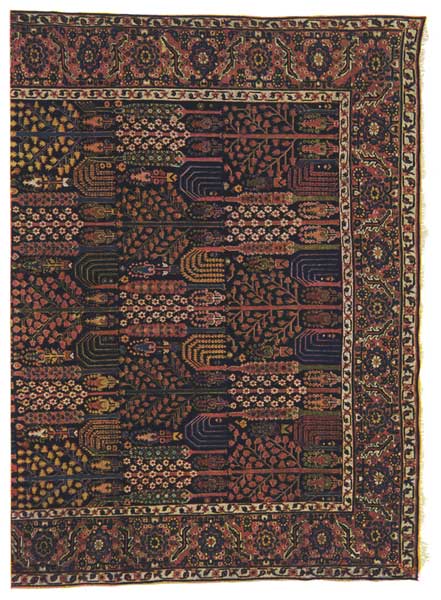
Size, 15.3 × 6.7
The tree design in its best and strongest elements is typified in this wonderful and most interesting Persian fabrication of olden time. The harmony of design and color is most impressive, and the size of the rug enhances this effect. It was evidently woven by one weaver, and years of patient labor and the greatest skill must have been bestowed on it. The richness of coloring, the velvet-like texture, the repose of design, are all unusual. The foundation is of a deep rich blue, and the exquisite rose and sapphire blues and ivory tones are in the softest and richest of permanent dyes. The border is wide, the main stripe of the rose shade, and the coloring all so blended that the continuity of the rug is complete. It is doubtless a product of Kurdistan.
View larger imageThe finest rugs are closely woven, with a pile like velvet, and with stitches on the back that resemble needlework. A rug has scarcely reached its prime until it has been down ten years; and it should last for centuries, if carefully used. As a partial explanation of this wonderful durability, it should be remembered[Pg 55] that in their own homes the Persians use their finest rugs for hangings, and also that they take off their shoes before entering the house.
In ancient days rug-weaving in Persia was generally restricted to Ispahan, Khorassan, and Shuster, but in modern times the most noted districts are those of Sultanabad, Fars, Hamadan, Feraghan, Bijar, Kurdistan, Khorassan, and Kirman. But the industry is so widely spread over Persia that there is not a class of women who do not live by it, and very often really fine pieces of work are produced in districts where the art receives no encouragement. The districts mentioned above are more noted for the quality of the rugs they produce than for anything else. The rug of each district has a peculiar character of its own, both as to the quality of the wool and the design. The peculiarities characterizing each district are so noticeable that an expert can generally tell at a glance where a rug was made.
It is very difficult, if not impossible, to discover the exact value of the export and import trade of Persia. The source of this information is naturally the Customs Administration, which in Persia exists but in name. The duties of the ports and principal towns are farmed out to various persons, whose interest it is to send the inquirer away as ignorant upon the subject as he was before the interview began. But it is possible,[Pg 56] after a great deal of labor in collecting statistics from the dealers of a particular article, to form an estimate probably not very far from the truth. By this method we judge that the average yearly export value of rugs in Aaragh (the Sultanabad district) is three hundred thousand dollars; Hamadan one hundred thousand; Bijar one hundred and ten thousand; Malair one hundred thousand dollars; Kurdistan fifty thousand; Fars seventy-five thousand; Kirman and Khorassan one hundred thousand; and in the less known districts collectively, fifty thousand dollars. The total of these figures classes the rug export in the very first order of exports. It is plain that this amount does not represent the full value of the manufacture, inasmuch as a great quantity of the goods does not leave the country. This quantity is perhaps small in comparison with that exported, but it is large enough to make the value nearly a million dollars.
It may be of interest to mention here that the export duty on rugs on the average is two and a half cents per square foot, and carriage to the seaports ten cents per square foot, while the import duty to the United States is forty per cent ad valorem and the specific duty ten cents per square foot.
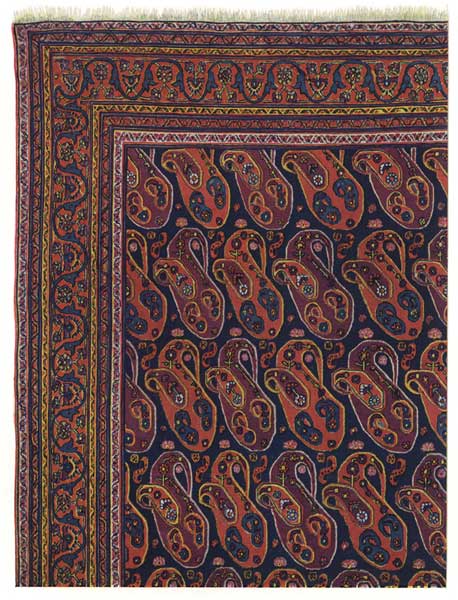
Size, 10 × 26
This is a perfect example of a Meshhed rug. The capital city of Khorassan has furnished many characteristic specimens of fine handicraft, but none more representative or beautiful. Here, on a splendid rich blue field, is the elongated palm leaf, with its markings of magenta, red, and blue. These palm-leaf designs extend over the entire rug, which is of enormous size. The border is in harmony with the field, and in coloring has the same deep, rich hues. The texture is firm and the rug is very heavy and imposing, with an air of solidity and strength. The illustration shows a section of this rug, giving a clear idea of its detail.
View larger imageIn Persia several firms have done a great deal in the way of encouraging the industry of rug-weaving in that[Pg 57] country. To supply the demand for Persian rugs in Europe and America, these firms have erected buildings in Sultanabad, where they keep the weavers under control and steadily employed. These firms, having been long established, are conversant with the Persians and their character; and to prevent any deception they pay the weavers by the piece instead of by the day.
The rugs produced by these firms are of the medium quality. The wool is bought in the rough and manipulated for use. Every day a quantity of it is given out to the laborers, who must reproduce the design placed before them, and each laborer is paid from two to four dollars per square yard, according to the quality of her work. In the service of these firms, the weaver is obliged to put aside her individual taste and follow closely the designs, which are prepared in accordance with the prevailing fashions abroad. The independent native weaver does not pay any attention to the taste of the buyer. She places her work in the local market, and the native merchant purchases it for exportation.[Pg 58]
Bakhshis rugs are made in a small village in the district of Azerbijan, and in the neighborhood of Herez. Those of thirty years ago were excellent, but now the materials of which they are made are poor, the rugs badly woven and of indifferent coloring. They come in large sizes, usually having a medallion in the centre.
Bibikabad rugs are quite modern, and are supplied to the market at Hamadan. Aniline dyes prevail, and the rugs are of inferior design and texture.
Bijar rugs of olden time were artistic; of those of to-day this statement cannot be truthfully made. The wool is still fine and silky, but there is an element of crudeness of design and a defiance of the laws governing color. A pronounced medallion in the centre is usually seen. This is set in a solid field of a strong contrasting color. Sometimes the field is of a bright red or blue, with the medallion omitted. The borders are generally in the same color as the field, or in camel's hair, sometimes covered with crude figures of human beings or animals, or decorated with flowers in vivid red, yellow, or green. The rugs are heavy, and in the American markets are known as Sarakhs.
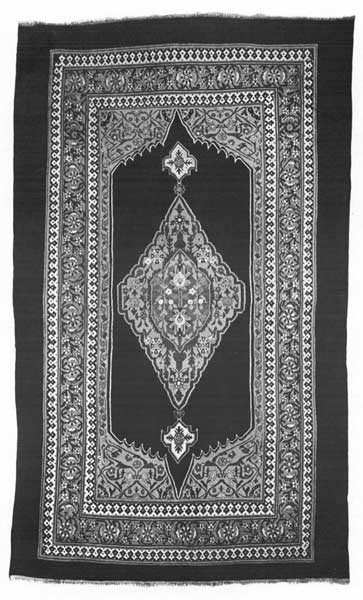
Size, 6.9 × 11.4
The texture of this rug is very fine. It is thick and soft, and very compact and smooth. There is a force both in color and design. On a deep blue field rests a medallion in rather strong colors, red, blue, green, and ivory. Heavily ornamented corner areas in the same shades give to the whole design a certain symmetry, and a wide floral border with much ivory gives an air of solidity.
View larger imageThe texture of this rug is very fine. It is thick and soft, and very compact and smooth. There is a force both in color and design. On a deep blue field rests a medallion in rather strong colors, red, blue, green, and ivory. Heavily ornamented corner areas in the same shades give to the whole design a certain symmetry, and a wide floral border with much ivory gives an air of solidity.
Birjand rugs (so called) are woven almost exclusively in the village of Daraksh, about fifty miles northeast of Birjand. The weavers of these rugs came originally from Herat. The rugs are generally satisfactory, the weaving being fine, although the pile is often uneven.
Burujird rugs are made sixty miles from Sultanabad, and south of Hamadan. They resemble in their field and in the firm texture the Saraband rug, the palm-leaf design being arranged throughout the field. The border is mainly white, with minute variations of the palm design.
Djushaghan rugs are woven in a district south of Feraghan. They are durable and attractive. The Shah Abbas design is a favorite one in antique rugs of this kind. The field is generally of a rich red, and occasionally a rare sage green. Often there is a lighter shade in the border than in the field. Crosses with angular ends are a feature, and between these are floral designs.
Feraghan rugs of olden time are as satisfactory as any rugs handed down to us. They are so harmonious in coloring and design as to be most restful to the eye. They have a richness and sheen that make them most desirable, and when to the usual soft colors a deep violet is added the attractiveness increases. A distinguishing feature is the Herati design, covering a field usually of a[Pg 60] rich deep blue. Sometimes the Guli Hinnai design is observed, with its more elaborate treatment. The border is often a light ground covered with a design in the form of rosettes and palmettes connected by a running vine. The main border stripe is frequently in a rich green and sometimes of a deep rose. When there are corner areas and a centre medallion they are arranged so symmetrically that the harmony is complete. The colors in these areas and the medallion are often in cream, light green, or red. At the present time Feraghan exports annually a large number of rugs rather loosely woven, but soft and durable. These are made by the Bactrian tribes. The entire centre is often filled with rather small irregular figures on a dark blue field. Yellow is often employed in a modern Feraghan, both in the border and in the field. Quite an important feature of Feraghan and other places of high altitude is the rug-woven saddlebag. When stuffed, such bags make comfortable sofa-pillows, or they can be placed as seats on chairs. Throughout Asia, saddlebags are used for the transportation of household and personal effects and other goods, and by children for their schoolbooks.
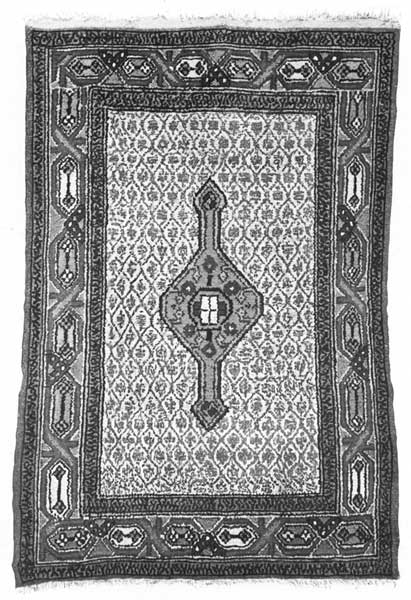
Size, 4.1 × 2.8
This rug is an example of the Hamadan weave, which is so frequently met. The field of camel's hair is in the natural color. The medallion in the centre is woven mainly in red, as is also the border of the mat. Both these, however, are ornamented with green, white, maroon, orange, and a few black lines. There is a fringe at each end of the rug, but at one end it is much deeper than at the other.
View larger imageGörevan rugs are woven in the neighborhood of Herez. They are exported in large sizes, and are generally rather showy and elaborate. Quite firm and[Pg 61] durable, they are popular for dining-rooms. As they are in great demand in the trade, they are turned out too rapidly, but careful selection brings happy results, for sometimes a truly beautiful rug, with rich warm coloring and a medallion not too pronounced, is found.
Hamadan rugs are generally of camel's hair, although sometimes goat's hair is added. The field is in the natural shade, as is the surrounding border. An elongated medallion appears in the centre; this is ornamented with floral designs in red, blue, and yellow, as are also the corner areas. Antique Hamadans are very beautiful. Soft and silky, yet with firmness of texture, and in subdued coloring, they seem appropriate for any room. Some of them, with fine, delicate tracery, in soft shades, remind one of beautiful stained glass seen in the old cathedrals of Europe.
Herat rugs are now woven in Persia by tribes originally from Afghanistan. The old city of Herat was under Persian influence, which accounts for the fine character of its rugs. The modern Herat rug is of excellent quality and durable. The leading design is naturally the Herati, and again one sees the palm leaf with its apexes all pointing in the same direction. The field is generally a deep blue, although sometimes a rich red, and even ivory. Green is apt to be the main color[Pg 62] in the border, and occasionally the butterfly motif is noticed. Some of the modern rugs have medallion centres, in which the wool is generally red or blue, and sometimes green or yellow.
Herez rugs are attractive, the chief color often being a fine blue, upon which rests a pronounced medallion. The corners are defined by serrated lines, and are in shades of the red in autumn leaves. Often these corners are decorated with small designs. The main border stripe is light in color—often cream—with good-sized markings. Herez rugs are made in the province of Azerbaijan.
Iran is the official name for Persia, and when a rug is called by this name, the meaning is simply that it is a Persian rug.
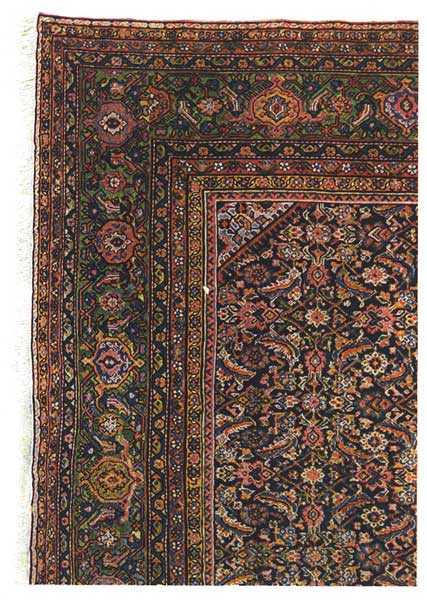
Size, 24.8 × 15
This is a most unusual antique Feraghan. It is rare to find an antique of such enormous size, and the marvellous sheen and good preservation of the rug render it a choice specimen. The texture is like velvet in its softness, the Persian knotting is firm, and the shadings of green, rose, blue, yellow, purple, violet, and red all blend in perfect harmony. The pile is even, and the border with its exquisite hues is a study in color blending. The green of the widest border-stripe is particularly reposeful in effect.
View larger imageIspahan rugs are antiques. During the sixteenth century and the reign of the great Shah Abbas, and even earlier, these magnificent fabrics were woven. Superb in coloring, with beautiful designs and of superior workmanship, the examples still in existence are indeed precious. In these old rugs one finds a field of red that is rich and rare. It looks like carmine, and then again it seems as if one were looking into a goblet containing the choicest wine of past centuries. Once seen, the shade is not forgotten. So also with the wonderful moss-like green that occupies the main border and[Pg 63] the running vines of the Ispahan rug. Black—the most corrosive of all dyes—although used, has disappeared, leaving only the foundation. A medallion, star-form in effect, often occupies the centre. Over the field are scattered palmettes and lotus forms, all connected by running vines. A wide middle border between two narrow stripes holds the rosette and palmette, and also the lancet leaf, in tiny form. When cloud bands are seen they show Chinese influence, as do the lotus forms.
Kara Dagh rugs are made by nomads who are called Aylauts, and who live in the mountainous region north of Tabriz. In appearance, as well as in texture and size, they resemble those produced in the Caucasian province of Karabagh on the other side of the boundary. The natural color of the camel's hair, and rose color too, are much used. Sometimes the camel's hair is mixed with goat's hair. The designs are floral and rather striking in effect.
Kermanshah rugs of modern make have usually a medallion with a lotus motif in the centre of the field. This is generally of ivory, ornamented in soft tones of blue, green, or rose. The usual light effect of the rug makes it rather more suitable for a reception room or a bedroom than for other places. There are, however, deeper tones in these rugs, and sometimes there[Pg 64] are no medallions. Perhaps the rug is most pleasing with the palm-leaf design and that of the tree, or with many birds and various floral conceptions. The borders blend harmoniously with the rest of the rug. The finest rugs of Kermanshah were formerly made in the palace of the Governor, and many were presented to leading rulers.
Khorassan rugs are woven in the province of that name and are characterized by various forms. A long palm effect or floral design is apt to be in the borders of antique Khorassans; and a prominent color in these rugs is magenta, which, though sometimes rather harsh in the modern rugs, is soft and beautiful in the antiques. Blue is also a leading color, and animals, including the lion and the gazelle; birds of several varieties; flowers symmetrically arranged, and geometrical forms, are all often seen. The Herati design is a usual one. When stripes occur in the field they are beautifully decorated with small floral designs or with the palm, and occasionally with that migratory insect, the locust. The rugs are unevenly clipped, which gives a soft, lustrous effect. Meshhed, the capital city of Khorassan, weaves rugs of fine colors; the palm leaf when represented on this rug is very large and impressive, often on a deep blue field. Animals and birds are frequently seen on the Meshhed rug.
Kirman rugs, made in the province of Irak-Ajemi,[Pg 65] frequently have a medallion in the centre, entwined with flowers. Sometimes the Tree of Life is represented, its branches bearing different fruits, and often there are symbolical little birds in the border. Sometimes a vase of flowers is the principal ornament, or several small trees either with or without foliage. Silk has often been introduced into the old rugs with charming effect. The Kirman rug is one of the most easily recognizable. It is of very fine quality, and is highly decorative. Antique rugs of this kind have the finest of wool, and, with the artistic arrangement of beautiful flowers, cypress trees, and palm effects, are most pleasing. One of the finest in this country is reproduced in this volume with a description accompanying it.
Kurdistan (the Persian portion) is a large region inhabited by the nomadic tribes called Kurds; and the sheep and goats belonging to these tribes furnish the fine wool that is woven into Kurdish rugs. The color effects are generally good. Often dark blues and reds form the groundwork, in the centre of which is a lozenge or large diamond form ornamented with small designs of the palm leaf. Then, again, a repeated design is laid out over the field. Designs of the tree, palm, and rosette, and various floral forms appear. By examining the web at one end, a design in colored wool is generally found. In one of these rugs in my own[Pg 66] collection the centre contains twelve different symbolical designs, including the turtle, comb, star, and cross, while the corner areas and borders hold at least thirty-five others. All of them are so carefully woven that much thought must have been bestowed upon this very strong, splendid rug.
Laristan (see Niris) rugs.
Meshhed (see Khorassan) rugs.
Mir-Saraband (see Saraband) rugs.
Muskabad (see Sultanabad) rugs.
Niris rugs are made a little to the southeast of Shiraz, in the province of Laristan, and the latter name is that used in the Western markets. All around Lake Niris are pastured sheep with fine lustrous wool which is used in the manufacture of rugs. In the modern ones floral and geometric stripes often alternate through the field, or there is a medallion in the centre of a plain field, with corner areas. The border carries several designs. There is a checked effect in the webbing at the ends. The rugs are very strong and excellent for hard use. In the older ones blue was used in the field, with rather large forms of the palm leaf.
Oustri-Nan rugs have the palm-leaf design over the field, and a good deal of white in the borders. They are firm and durable.
Saraband (Serebend) rugs are woven in the district[Pg 67] of Sarawan. They always have a distinct feature in the small palm leaves that fill the field. These leaves have the hook turned at the top from left to right in one row, and right to left in the next. Usually the field that these palm leaves adorn is soft red or rose in color. Again it may be deep blue, or occasionally ivory, in which case the palm design is in red or blue. The border is always harmonious, and there are many narrow stripes which form it. The widest one is generally in an ivory tone, while the undulating vine and small flower forms appear in some of the borders. Then, too, one finds the Caucasian influence in some of the borders, and the reciprocal trefoil is often seen. Occasionally a human figure is carefully outlined in the border, and this brings a personal element into the rug. Then again, the date is woven in. Mir is the name of the village in this district where the design had its source, and in the trade to-day the finest of these rugs is often called Mir-Saraband.
Sarakhs (see Bijar) rugs.
Saruk rugs are very closely woven in the hamlet bearing this name. The floral designs scattered over the field of rose, dark red, or blue show a spontaneity of workmanship that is not governed by Western enterprise, though, curiously enough, aniline dyes prevail. The wool is very fine. The border is composed of a wide middle stripe, with a narrow one on either side.[Pg 68]
Savalan (see Sultanabad) rugs.
Serapi (see Sirab) rugs.
Shiraz, the capital city of Pars, has exported some of the most interesting and exquisite rugs in existence. In the sixteenth century Shiraz was at the height of its prosperity, and all the neighboring country was noted for its flocks of sheep, which produced the finest of wool. Rugs were made at Shiraz for the reigning Shahs, who had palaces there, and the workmanship displayed in them was most beautiful. The city was visited by an earthquake in 1853, and since that catastrophe the manufacture of rugs has not regained its former prosperity; yet great improvement has been shown in recent years, and the same vegetable dyes are still in use. The Shiraz is often called the Mecca rug, as it is the one frequently selected by pilgrims to that city. Deep rich blues are often seen in a Shiraz rug, and frequently stripes extend throughout the centre, as well as in the border, where diamond forms and crosses are also frequently seen. The medallion and the palm leaf are also found. Many Persian poets have sung of the wonderful rose gardens of Shiraz, and the rug weaver there has faithfully reproduced in glorious hues these beautiful flowers. Other flowers, too, decorate this rug. The webbing at the ends is embroidered in colored yarns.
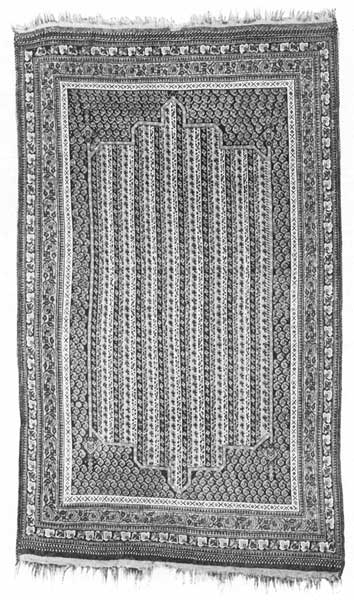
Size, 4.3 × 7
The field of this rug is marked with narrow perpendicular stripes of soft yellows, rose, deep blues, and ivory. These mellow tones of color are all thickly studded with a fine floral design in contrasting shades. The palm-leaf design, minute but distinct, is in pale green, with markings of blue and rose. The border stripes of tan, dark rich blue, and rose are floral in effect. The rug is heavy, firm, and of fine texture. Fringed ends finish this beautiful example of the Shiraz.
View larger imageSinna rugs are made in the province of Irak-Ajemi. They have a very fine texture, and are greatly prized by rug-lovers. The pile is of the best wool, and very closely cut. The Herati design, minutely woven, often occupies the entire field. Again, a lozenge-shaped figure is in the centre, and covered with the most delicate tracery. The field of the rug is often in white or ivory, or in soft blue, red, yellow, or even peach-blow tint. Yellow is used frequently in the border and corner areas. Often the finest of these rugs will be puckered near the edges; that is because the yarn is so tightly twisted in the weaving. Owing in part to this firm twisting and also to the fine, close knotting, there is much durability in the best specimens.
Sirab rugs are woven in the village of that name in the district of Azerbaijan. In Western markets the name has been corrupted, and the rugs are there called Serapi. These rugs come in large sizes, and are of excellent colors. A medallion of good proportions occupies the field, and about this floral designs are arranged. Sometimes inscriptions are seen in the rug.
Sultanabad is one of the most important of the modern rug-producing regions of Western Asia. Factories are kept busy supplying the market, and in many cases excellent rugs are manufactured. This is especially true when old patterns are used, for no modern ones sent[Pg 70] out by Western firms can be deemed worthy to take the place of original Oriental designs. Large quantities of rugs from this district are exported to the United States, and are then frequently called Savalans. The groundwork is generally light in color, and the designs are many, while the variety of brilliant hues is perhaps the largest in Persia. Muskabad is a trade name for a certain grade of rug from this district.
Tabriz rugs are now supplied in large bales to the trade from factories that are under Western jurisdiction. They are of well selected yarn, closely woven, and very durable. The weaving is faultless. The centre medallion is in a rich color, set in a field of ivory or other solid color, and decorated with floral forms. The sharply defined corner areas and the borders also contain floral designs in attractive colors. Sometimes cartouches with lines from a Persian poet or birds and animal forms are seen in the borders.
Yezd, where the fire-worshippers live, furnishes rugs with a short pile, but these are used chiefly in mosques, and seldom leave Persia.
A fine Persian rug is valuable, even at the seat of manufacture. A small one, measuring three by four and a half feet, quite modern, but very fine and with splendid colors, has been sold at Teheran for eight hundred dollars.
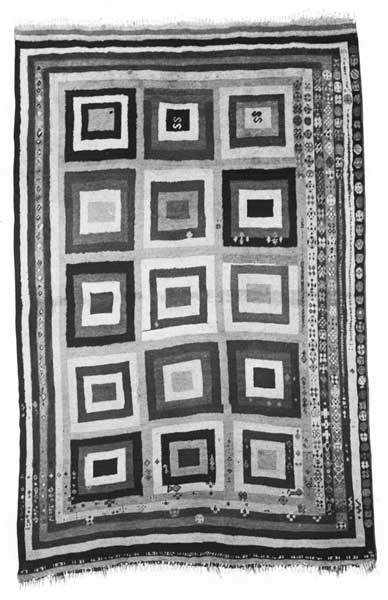
Size, 4.10 × 7.5
Although distinctly Arabic in style, this rug was probably woven in the vicinity of Shiraz. The squares which form the design resemble an old-fashioned log-cabin quilt in the variety of their colors and the regularity of their stripes. Some hues are green, then red comes into play, while plum, brown, yellow, and blue are also employed. The wide border of stripes shows the Shiraz ornamentation in its beauty, and the Greek crosses suggest the possibility of a Christian weaver. There is a fine sheen on the surface. This rug is quite heavy, and its very oddity makes it interesting to the collector.
View larger imageThe term Turkish Rugs includes all those rugs that are manufactured within the Turkish Empire, whether the manufacturers be Kurds or Circassians or Christians; the last of these names comprises the Armenians, the Greeks, and the Syrians. Turkish rugs are not so finely woven as Persian; they have a longer pile and looser texture. As they are usually very soft and thick, the foot when walking upon them feels as if it were treading upon a bed of moss.
The principal rug-manufacturing district of Turkey is Karajah Dagh. Much weaving is done also at Cæsarea. The rugs found at Adana are generally from the latter region, while those sold at Urfa are either from the Kurdish territory or from Persia. In Constantinople are seen rugs from almost every part of Asia, but the greatest number are from within the Turkish territory of Transcaucasia.
Each rug-weaving district of Turkey seems to have a distinct and individual class of rugs; and this is not surprising, for there are a number of different tribes, each of which impresses its individuality upon the work. The surface configuration and the climate of a place[Pg 72] have much to do with the quality of the rugs manufactured within it. Naturally, in the rocky, mountainous regions the flocks consist of goats instead of sheep. The sheep would be injured among the steep, sharp crags, and much of their wool would be lost, as it would adhere to the rocks. The goats, however, being hardy, easily jump from crag to crag, sustaining no injury to their hair.
The hair of the goat is woven into the mohair and so-called Smyrna rugs, and also into what is known as Paul's Tent Cloth. This last is woven quite differently from other rugs; it is the coarsest of all, and the women weave it on the ground. To make it firm enough to keep out every drop of rain requires laborious work with the fingers, but when the cloth is woven with care it is a most excellent shelter from the storm. A large Paul's Tent, such as a rich man owns, costs about four hundred dollars. It shelters the women of the household, as well as the cattle; and one part is partitioned off for a guest-room.
In Turkey the floor is always covered with matting, and the matting, in its turn, is so closely covered with rugs as to be quite concealed. In large cities rugs are used in the Summer for divan and couch covers; in the Winter the same rugs serve as beds.
Constantinople is the greatest rug market in the[Pg 73] world. Every known nation is represented in that wonderful city, where the ancient industrial skill of Asia meets the steadily increasing demands of the West. Nothing can be more interesting to the rug-lover than to wander through the streets and byways, observing the different phases of his favorite industry. The Custom House, where enormous bales of rugs await transportation; the great warehouses, which handle only at wholesale; the bazaars, and even the street vendors, possess each an absorbing interest. The travelling merchants from Persia, who yearly journey to Constantinople, establish themselves in that busy section of the city known as Stamboul. Here they erect their khans, covering the walls and floors with rugs, many of which are really splendid in tone and quality. The large retail houses at Constantinople usually have collections of very choice rugs.[Pg 74]
Akhissar rugs have a thick pile, and are loosely woven. Their colors are usually red and green. Rugs of mohair are made at Akhissar.
Anatolia, or Asia Minor, produces both rugs and mats of good quality. The Anatolian rug is large and very heavy. The Anatolian mats are made in large numbers, and are very thick and soft. They are used by the natives for pillows. Some are very beautiful; and although many are turned out with aniline dyes, many others are splendidly colored with vegetable dyes. The designs are many and varied.
Bergamo (ancient Pergamos) rugs have a long, silky pile, and are almost square. They are quite thick, and have geometrical figures in the centre, while the borders are floral in effect. The colors are rich, generally yellow, green, red, and blue. A red webbing at each end carries a blue or yellow embroidered stripe. Antique Bergamos are very beautiful.
Brusa (Broussa) had a fresh impetus in the rug industry a few years ago. Very fine and beautiful silk rugs are woven there now by Turkish women and girls. The Great Mosque and the Mosque of the Thunderbolt at Brusa both contain rare old rugs.
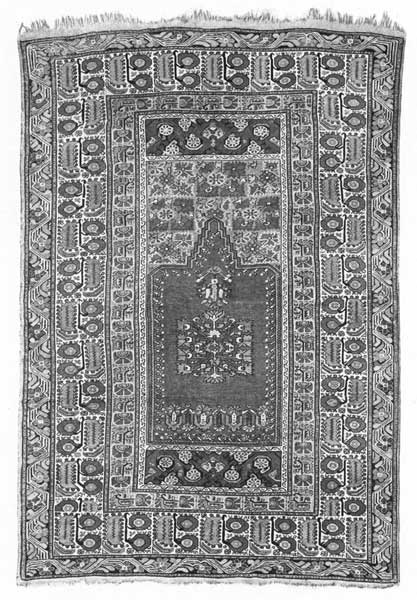
Size, 4.6 × 6.9
The rich magenta which is the field of this rug has been mellowed by time. There is throughout the rug a softness and harmony of tone that is very pleasing. The niche is high, and the corner areas and the border are in richly blended blues and yellows, with magenta. The delicacy of the floral designs, and the warmth of tone, give it a particular charm.[Pg 75]
View larger imageCæsarean rugs have a thicker pile than any of the rugs woven in Anatolia. They are garish in color and are stained with chemical dyes. Large numbers are turned out by the factories, but they in no way resemble the good rugs of former years, except in their durability.
Cassaba (see Sparta) rugs.
Demirdji rugs are a product of modern growth, unknown thirty-five years ago. To-day the town is a large manufacturing centre. The rugs bear strong Turkish elements. They are heavy and durable, and woven of excellent wool when of the first quality. There are, however, three different qualities. The weavers of these rugs have a small pattern which they reproduce in the large sizes.
Ghiordes rugs of antiquity are not in the market. Once in a decade it is possible such a rug changes hands, but this is either the result of lack of knowledge on the part of the owner, or because he is in pecuniary straits. The rug derives its name from the ancient town of Ghiordium, and its form is that of a prayer rug. The weavers were most painstaking, and used the finest of dyes and designs. The hanging mosque lamp, or a tree form, is suspended from the high point of the niche, and a column appears on either side of the field, extending to the spandrels. Above is a horizontal panel, and there is generally one below the field. In colors there[Pg 76] is a discriminating use of the old porcelain blue, rare green, red, yellow, ivory, and white. When white was chosen, the weavers often substituted cotton for wool, thinking it would keep its purity of tone longer. The field is generally in one of these solid colors. The borders are most interesting and beautiful. The main stripe is usually ornamented with well-defined designs of small flowers and leaves, arranged with a square effect. The other borders are generally floral, while the zigzag water motif encloses the field. The apex of the mihrab or niche runs high in the Ghiordes rug. A silk fringe often finishes the top. One collector in Constantinople has many very fine and rare specimens. He began to collect Ghiordes rugs years ago, before the value of the rug became generally known. The modern rugs are very coarse, and have no resemblance to the old ones.
Hereke rugs receive their name from the village about forty miles from Constantinople, on the Gulf of Ismid, where the Sultan has established the imperial factories and a school of art. About four hundred young women, mostly Greeks, are here actively employed in weaving rugs in silk and wool. His Imperial Majesty is anxious to give employment to the village girls, and takes much interest in this industry, which was started about fifteen years ago. The rugs are reproductions, for the most part, of famous antiques belonging[Pg 77] to the Sultan. In 1898 Emperor William of Germany visited this factory. After his return home the Sultan sent him a large number of Hereke rugs. In 1902, during one of my sojourns in Berlin, I was permitted by the courtesy extended to me by the court official in charge of these rugs to see the entire collection arranged in one section of the Palace. Beside the magnificent antique Persian rugs belonging to the Imperial House of Germany these modern Turkish rugs were startling in color; but the texture was fine, and time will, of course, subdue the glowing colors, which are now often softened in the Western markets by a washing process known to certain firms. Old mohair rugs are also being reproduced at the Hereke factory with good results. Great attention is paid in all these rugs to exactness of detail in reproduction.
Kara-Geuz rugs are mostly of the runner order, with mixed designs and fugitive colors.
Karaman has a considerable trade with Smyrna. Its rugs are coarse, loosely woven, and not at all attractive.
Kir-Shehr rugs are made in the province of Angora. Because of their durability and thickness they are both useful and desirable. Their colorings are rather strong, but fine; green is the most usual color, although red and blue are frequent. The designs are mostly of Arabic origin, and quite highly decorative.[Pg 78]
Konieh rugs are of great weight and resemble Ouchaks. They usually have a plain centre, and when there are panels these are also of one shade. Being firm and strong they are very durable.
Kulah prayer rugs of ancient make are most interesting and valuable. They are about the size of the old Ghiordes prayer rug, and have other points in common, which might be expected from the proximity of the towns. The Kulah rug, however, instead of the solid centre of its neighbor, is apt to have its field ornamented with small floral designs. The colors most prominent are a yellowish-brown, a blue, or a soft red. Green and white are seen at times. There are many narrow stripes as borders, often alternating in dark and light colors, and these are beautifully ornamented with floral effects in minute designs. The niche of the prayer rug is of medium height, often with serrated sides.
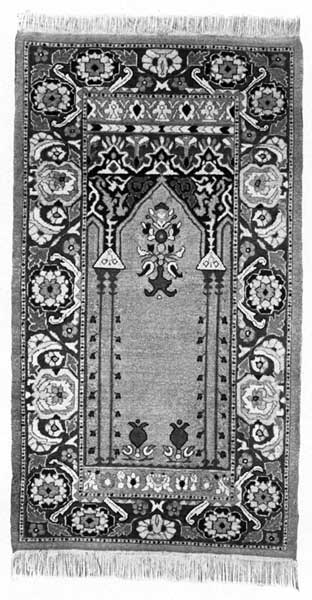
Size, 5.10 × 3.4
This rug is a modern product of India. The prayer niche, with long lines leading to it, extends well toward the top. The niche is decorated with a delicate, dark blue floral design in ivory, red, and fawn, and the lines leading to it are ornamented in blue, red, and brown. The field is a beautiful sage-green, and the main border is embellished with reds, browns, ivory, and occasionally with light blue. The outer border is of the same green as the field. At each end is a full fringe. This rug was made in the jail at Amritsar, from a design sent from the United States.
View larger imageKurdistan (the Turkish portion) rugs are woven by the women in odd moments, and one of the ways a girl gains distinction among her associates is by the skill she displays in rug-weaving. As the wool is taken from the flocks that are kept near home, and is spun and dyed there, and as the time consumed in the weaving is not counted, each rug is considered clear gain. In fact, the Kurdish women do not make their rugs entirely for the market, but for their own entertainment and use.[Pg 79] Kurdish rugs are very durable, and they are much prized in Turkey; but they do not sell readily in America because of the lack of that harmony of color which our taste demands. Their coloring is often too bright and varied to attract us. An Armenian clergyman said to me recently: "I find Americans more devoted to harmony than to anything else. I have in my house one of the finest of Kurdish rugs, but I could never sell it in this country, should I wish. An American looks at it and says, 'What hideous colors!' and I doubt if I could even give it away, although it would be considered a superior rug in Turkey."
Kutahia sends out Anatolian rugs of goat's hair and wool. Some improvement has been noticed in the rugs recently.
Ladik prayer rugs were made in the ancient city of Laodicea. They are among the finest rugs of old workmanship. The field is of a solid color, often a rich wine-red. The niche is serrated on the inside to the apex, which is enclosed by straight lines. On the outside of the niche one often sees the hook design, extending into the upper field, which in its turn is frequently ornamented with lancet-shaped leaves and floral forms. The Rhodian lily sometimes plays a part in the border design. White, red, blue, a light tan, and green, with an occasional touch of violet, are used.[Pg 80] The webbing is red, and extends about an inch and a half, when a narrow fringe finishes the ends.
Meles (Melhaz) rugs of modern make are of coarse texture, and brilliant in fugitive dyes of red, yellow, blue, and green. They find a market at Milassa. The modern prayer rug does not compare favorably in any way with the antique. The texture of the ancient rug is thin, but with a wealth of coloring and blending of hues, as beautiful as rare. Sometimes, too, the Ghiordes panel is seen above the niche. A good deal of black was used in the old rugs, but, as is usual in antiques, it has gradually disappeared with age. Violet, too, is a color that was sometimes used with great effect in old rugs.
Mohair rugs are made of the soft, silky hair of the Angora goat; but though beautiful, they are not durable, as experiments tried at Akhissar and Kulah have shown.
Mosul rugs are strong and rich in colorings of blue, yellow, green, and red. The designs are rather striking, and with their silky softness these rugs are generally desirable. The best are made of camel's hair, including the outer border, but occasionally they are made partly of goat's hair. They are now made in several Turkish provinces, and are often wrongly called Persian rugs.[Pg 81]
At Ouchak, with its large population, there are steadily at work about two thousand looms, giving employment to fully four thousand weavers, and as many as one hundred and fifty dyers. Ouchak is the principal city of Asiatic Turkey for the dyeing of the wool of which the rugs are woven, and that industry is carried on in many factories. Ouchak rugs have a thick pile; and though green is forbidden by Mohammedan law, the modern rugs frequently have green for their dominant color. The reason for this innovation is that the influence of their religious faith has waned, and consequently the law regarding that color is not now strictly enforced. The weavers of these rugs are mostly Moslem women and girls. The wool is generally bought in the interior from nomad tribes, and the weaving is carried on in private houses in a manner similar to that of other rugs, except that the yarn is spun more loosely. In the early history of rug-weaving these rugs were known in the Western market as the Yapraks, and the colors were, almost invariably, red with either green or blue. Until recently, even the best Ouchak rugs were apt to have inferior wool for their foundation, and hemp was frequently employed. The wool was loosely woven, and the dyes were fugitive. There are now, however, certain provinces in Turkey, including Ouchak, where the products are controlled by European and American firms,[Pg 82] and where excellent wool and natural dyes are used. The rugs made under such control are very durable and in every way satisfactory. In size Ouchaks vary greatly, ranging from a few feet to fifty by twenty-five feet.
Sivas rugs are always woven of wool, and almost every hamlet carries on the industry of weaving in the homes. There are no factories, the young girls and women doing the work here, as in other parts of Turkey. Sivas rugs are in most cases small, measuring about eight by four feet; but lately larger and more attractive rugs are being made. Even the poorest families have fine rugs, and regard them as valuable property, to be sold only under the pressure of great extremity. The weavers are so frugal in their manner of living that their daily earning of fourteen to nineteen cents is sufficient to supply their wants.
Smyrna, next to Constantinople, is the most important commercial centre in the East. It is the open door to mysterious Asia, and within its boundaries are found representatives of every race and religious belief of that little-known continent, the land of mystics, nomads, and fanatics. It is a mistake to imagine that the so-called Smyrna rugs are made in that city. As a matter of fact, no rugs are manufactured there. It is the export depot for goods from the interior, and dealers have allowed the name to be used merely for convenience, for commercial[Pg 83] purposes. A student of rugs can readily understand that throughout the vast territory which concentrates its commerce in Smyrna there are a score or more of valuable manufactures which could never be known under one descriptive name.
Sparta rugs are made in a village bearing that name situated in the interior not far from Smyrna. They are very heavy, firm, and in different colors. Some of those recently made are especially fine. Attention is being paid to harmonious coloring as well as to quality and texture. A splendid specimen is in the home of the leading merchant of Smyrna. It is in the softest shades of rose and blue, with a lustrous sheen. The texture is as fine as velvet, and the medallion in the centre is most gracefully designed. Many rugs are sold under the name of Cassaba, which are really woven at Sparta.
Yaprak (see Ouchak) rugs.
Yuruk rugs are so called from a band of nomads who dwell among the mountains of Anatolia. They have large flocks of sheep, and weave rugs of strong, hardy texture. The colors are very good, the field often of brown, ornamented with large, bold designs.
The manufacture of rugs was introduced into India by the Mohammedans at their first invasion in the beginning of the eleventh century. Persian rugs, however, were always preferred to those made in India, and princes and nobles of the Delhi Court, when it was in its greatest splendor, sought the fabrics woven in Herat, or by the Sharrokhs on the Attrek, or the nomad tribes of Western Kurdistan. These were purchased only by the princes and their wealthy followers. A few specimens of these rugs still remain in India, and are now and then reproduced with more or less accuracy.
In the sixteenth century, however, the Emperor Akbar, or more properly Jalal-ud-Din Mahomed, sent for Persian weavers to make the exquisite fabrics for which Persia was then so famous. At first these weavers continued to weave according to the designs employed in their own land; but it is not surprising that as time went on, and the natives of India learned the art of[Pg 88] weaving from the Persians, Hindoo ideas should have found expression, in Southern India especially. Thus geometrical designs were substituted for floral, although even now the designs of some Indian rugs revive memories of Persian teachers in the careful arrangement of flowers and leaves. The designs of Indian rugs were frequently named after the original owners, in which cases the weavers generally lived and worked in the houses of their employers. At the present time the manufacture of many Indian rugs is carried on largely in jails, where the old Persian designs are generally used.
In Indian rugs, as in those of other countries, there are certain distinct characteristics that stamp them as coming from particular districts, and in India alone are to be detected the few Assyrian types still in existence. Genuine old India rugs are works of art, but they are rarely seen.
The religion of the Hindoo does not permit of his tasting the flesh of sheep; and as India is not a wool-producing country, except in the northern part, cotton is often substituted. For this reason, and because the time consumed for weaving is less, Indian rugs are generally less expensive than Persian.
Mr. Julian Ralph, in an interesting account of his visit to the home of a prince in India, published[Pg 89] in one of our magazines, writes of the splendid rugs shown him by his host: "They were state rugs, and one was green with a border of gold that must have weighed twenty pounds or more. The other was red with a similar border, so stiff and cumbrous that it did not seem made to walk upon. However, the prince sent for his stiff-soled heavy-heeled ceremonial shoes which were quite as richly crusted with gold, and walked about on the rugs, crushing the gold embroidery in a ruthless way." When Mr. Ralph spoke of the damage, he said, "It is of no consequence, these borders have to be renewed very frequently."
An Indian rug of great beauty was taken to England from India by Lord Clive, who ordered the architect of his magnificent palace—Claremont—then in process of building, to design a room especially for it. Such special care for the proper display of this work of art may be exceptional, but it shows true appreciative power on the part of Clive.
From the time of the decadence of the industry of weaving fine shawls, which was so long a feature of Kashmir, the wool of which they were woven was gradually transferred to the rug industry, and the weavers turned their attention from the shawls to the rugs, on which they displayed the same patience and skill.[Pg 90]
Agra sends out very satisfactory rugs. These are mostly of great weight and thickness. Many of the best are woven in the jail. The finest specimen that I have seen belongs to Mrs. Potter Palmer, of Chicago, and is a duplicate of one owned by Mrs. Frederick D. Grant. The rug is of enormous size and weight, and the tree design is arranged in shades of exquisite blue upon a field of delicate fawn color. The border, in the same coloring, gives the most perfect harmony to the entire rug. Many more Agra rugs would be imported, but there is now a United States law prohibiting the importation of goods made in jail.
Allahabad rugs are similar to those of Agra, but the latter are as a rule preferable.
Amritsar gives employment to over twenty thousand men and boys, and supplies the market with some of the finest of modern Indian rugs. Leading English and American firms have factories located there, and for that reason rugs brought into the Occident from Amritsar are reliable. They are firm in texture, and have fast colors. The manufacturers realize the importance of these attributes in a rug, and their own responsibility in the matter.[Pg 91]
The Dhurrie (Durrie) is a strong, well-made rug of cotton, often in stripes of blue, brown, or gray, with narrow yellow and red lines. Some Dhurries end in a fringe, and are square. In India they are largely used by the foreign population, and in the United States they are especially appropriate for summer time. They are made chiefly at Agra, Cawnpur, Delhi, Lucknow, and in the vicinity of Bombay.
Ellore rugs belong to the inexpensive class, but the designs and colors are pleasing. As they are made chiefly of fibre mixed with wool, they are not durable.
Formerly Haidarabad sent out rugs famous for their beauty, with designs in the forms of medallions, filled with flat floral ornaments and woven with wool pile on a cotton foundation. But the modern Haidarabad by no means compares with the antique.
Jaipur rugs are generally made in the schools of art. They contain many Persian designs representing animals and the cypress tree. The borders are floral, and the field is generally ivory, red, or blue.
Lahore, the British capital of the Punjab, has rugs woven in both wool and cotton, and the work is done mostly in jails. The designs are Persian, and the texture embraces from forty to one hundred knots to the square inch.[Pg 92]
Madras rugs are chiefly made in large quantities for commercial and export purposes.
Masulipatam rugs were once noted for their beauty, but now many of them are poor in design and workmanship.
Mirzapur rugs are sometimes wrongly sold for Turkish, which they somewhat resemble. The antiques are very durable, but this cannot be said of all the modern ones, the vegetable fibre that is used in part in the construction of them not being durable. Few are exported to the United States. The colors are often black, orange, or grayish-white.
Moodj is the name given to a coarse, hardy mat, suitable for the veranda. It is made of buffalo grass, which grows six to twelve feet high in India. This is harvested, the fibre extracted by pounding, and then it is twisted into rope or yarn. Afterward it is dyed.
Multan rugs have large geometrical figures in octagons, medallions, and circles. These rugs are very lasting. Their general coloring is dark red and blue. Sometimes a really beautiful modern Multan is discovered. Occasionally an emerald green or a yellow alternates with the usual reds and blues, and again we see a white ground with blue designs. The modern ones are not largely imported into America. The antique Multan is very fine, but scarce.[Pg 93]
Mysore rugs are cheap and not interesting.
Patna rugs are usually in blue and white; in quality they resemble the modern Multan.
Pushmina rugs have their name from the manufacturers, who thus designate rugs that are woven of pashim.
Sindh rugs are the cheapest and least durable of all Indian rugs, and on this account not many are imported into the Western market. The colors are green and orange.
Srinagar, the capital city of Kashmir, makes very beautiful rugs from the finest wool. This is soft and silky, and as natural dyes are employed, the Srinagar rugs, as well as many other rugs from the northern portion of India, are highly valued. Antique rugs of this character are attractive in soft tones of rose and yellow.
Warangul rugs. At Warangul, in the eastern part of the Deccan, modern rugs have been woven for the past sixty years. The designs are chiefly Persian, with a strong Indian influence. To show the beauty and delicacy of some of the old rugs, I may mention that one was made at Warangul, in the sixteenth century, which contained 3,500,000 knots on its entire surface, or 400 knots to the square inch, and the designs were so complicated that a change of needle was required for every knot.[Pg 94]
Leading importers now give names to designate the different qualities of India rugs, and therefore the name borne by a rug does not necessarily indicate the district in which it was woven. For example the Dhurrie rug is woven in several districts of the northern provinces.
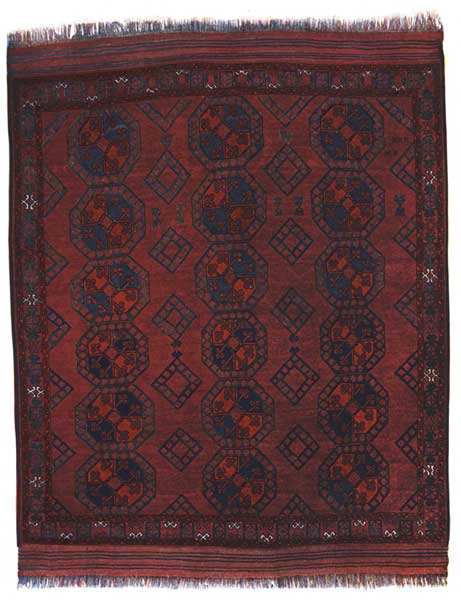
Size, 9.5 × 7.6
This rug has a remarkably soft yet firm texture. The rough beauty and the fine coloring are very attractive. The field is a rich shade of red verging toward the hue of a blood orange, and again gleaming with far deeper shades. The large octagons are defined by a very narrow dark brown line. Two sides of these octagons are in a deep, sapphire blue, while the remaining two sides are of an orange cast. The octagon sections are all ornamented, the small red diamonds at the edges being separated by dark green lines. The lattice-work design in the squares of the border of the rug are decorated with green and ivory, the latter in the hook design. The centres of all the octagons are of the orange shade, and one only is crossed through the centre, the markings being knots of green. Large diamond forms, barred with sapphire blue and rich green, are between the octagons on the field. Occasionally a small geometrical figure in either blue or green, with pale yellow or ivory, is seen, and a wide red webbing with heavy dark brown lines across it extends at some length beyond the border. The rug was woven in that northern region of Afghanistan known as Afghan-Turkestan.
View larger imageAfghanistan rugs are generally large and nearly square. They are coarser than the Turkoman rugs, but resemble them in color and design. The Afghans, however, are more striking, the octagon designs being larger and bolder. At Kabul, the capital city of Afghanistan, and in other cities rugs are found which are made by the nomad tribes on the frontier. The same tribes weave also the cotton and silk rugs said to be woven at Bhawulpore, India. The Great Rug in the Palace of Chehel Sitoon (forty pillars) at Ispahan, Persia, is said to be the largest ever woven, and to measure about sixty feet long by thirty feet wide. This rug was made in the sixteenth century, and is of Herat design and manufacture. Owing to political disturbances, weavers from Herat have settled in the province of Khorassan, Persia, since 1838, and prefer to call that their home.
Some rugs have a strong odor, which is especially noticeable in those of Afghanistan. The reason for the presence of the odor is that the animal's hair has not been properly washed. Nothing but a thorough cleansing on the back as well as on the surface, with soap and hot water seems to be effective in carrying it away, although certain atmospheric changes affect it.[Pg 96] A damp, wet day brings out the odor strongly. Fortunately this disturbing element is not in all Afghan rugs. There is a great deal of force and strength exhibited in these rugs, and a richness most attractive in the finest specimens. A color plate in this volume, with its accompanying description, explains the typical Afghanistan rug.[Pg 97]
Beluchistan rugs bear the marks of nomadic workmanship. They show that they are woven by tribes who combine strength and skill. The designs are generally geometric, and bold in effect. The rugs have rich dull tones of blue, red, and often with markings of white or ivory on a foundation of dark brown, in fact so dark sometimes as to give the appearance of black. This is accounted for partly by the great abundance of goat's hair and camel's hair woven into it, which is sometimes dyed even darker than the natural color. There is a fine lustre in this rug, and it is one of the hardiest and most durable of all the Oriental rugs. The wool used is soft and the pile left rather long, which accounts in part for the rug being so thick and heavy. Occasionally we find a beautiful old prayer rug in brown tones, and with corner areas in fine dull reds and a wonderful deep rich blue.
Some of the finest specimens are occasionally sold as blue Bokharas; and people who imagine that they have purchased one of the latter are likely to find themselves the possessors of a good Beluch, for there is no such thing as a blue Bokhara.[Pg 98]
Turkoman rugs are woven by nomad tribes living in Central Asia. The tribes are known as the Ersari Goklan, Sarik, Tekké, and Yomud, and most of these rugs have some points in common, although they vary a good deal in detail. Generally speaking, the Turkoman takes the greatest care to have his work perfectly done. In order to give fixity to the color the dyer steeps the wool in a mordant of alum and water. The dye is almost invariably brought from Bokhara. At Ashkabad the Turkomans dye the wool themselves when it is intended to be yellow, but when any other shade is desired it is sent to the city to be dyed. Camel's hair is largely used in the rug-weaving of Central Asia. The camel itself is carefully washed, and the soft hair growing next its skin is used for fine rugs. The goats of this vast region also receive the same watchful attention as the camel; the soft, silky fleece is accounted precious, and is used for the finest Turkoman rugs. The natives use their rugs not only for the floors of their tents, but as portières, thereby dividing the[Pg 99] tent into sections. This is one of the reasons for the heavy fringe one so frequently sees on the ends. It permits of hanging, and is very strong, as is the case with the Turkoman rugs themselves, no matter how fine the texture.
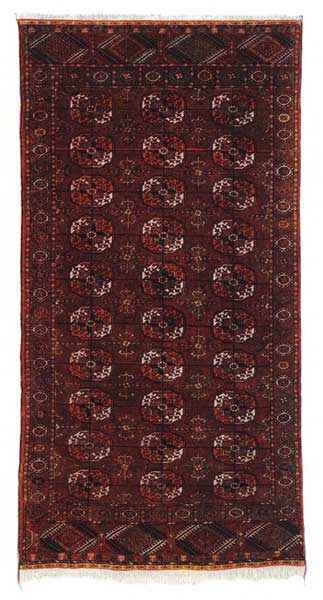
Size, 6 × 3.1
The field of this rug is of a deep rose hue, with a soft lustrous sheen. The texture is like velvet, and every stitch shows that the rug has been woven with the greatest care. The octagons are divided into four sections by distinct lines. The colors are orange, turquoise blue, and a deep blue with markings of yellow and ivory. Between the octagons are eight-pointed stars. The border is minute in detail, and the rug itself is a genuine treasure.
Owned by Mr. Ralph Oliver Smith, New York.[Pg 100]
View larger imageBeshir rugs resemble in certain aspects the rugs of Afghanistan. The texture is similar, and the same rich blues and reds are seen; a red webbing at the ends extends at some length, and has dark lines crossing it. The rug is longer than the Afghanistan. The field differs. There is an Arabic effect in the design, and yet with a reminder of the Yomud in the general aspect. But the hook, which plays so important a part in the Yomud, is missing.
Bokhara rugs which are made in the city and Khanate of that name, are not the so-called Bokhara rugs of the Western world. The genuine Bokhara rugs are of good size, with large patterns, and are very strong and forceful in character. They are sold in the Occident under the name of Khiva or Afghanistan.
Genghis (often called Guendje) rugs are woven by a tribe of Turkomans who live the life of nomads. They are named after Genghis Khan, the great Mogul conqueror who invaded Central Asia in the year 1218. The rugs are woven of brown wool, or strong goat's hair, and have rather a long pile. The designs are mostly geometric, although the palm leaf and vine are often seen.[Pg 101]
Guendje (see Genghis) rugs.
Kashgar rugs are made in Eastern Turkestan. They are quite coarse, with designs of a Chinese character in strong coloring. Yellows and a sort of lead-white are much used in these rugs; again, blues and ivory-white are seen, while reds, pinks, greens, and a deep orange are common. The Chinese fret, the dragon, and fishes are among the designs employed. The Tree of Life is of frequent occurrence, but is a crude representation.
Khalatch rugs are woven by a division of the Ersari tribe of the upper Oxus, bearing the name Khalatch. They are included under the one greater head of Turkomans. The rugs are recognized by the single stripes of bands that divide the field both vertically and horizontally. These bands are ornamented with single motifs, and are generally considered to be the earliest decoration of woven fabrics. Besides the bands, stars, crosses, forms of the hook, and small prayer niches,—one at the top and one at the bottom, but each facing in the same direction,—are seen. Often a stark tree effect is noticed. In the trade these Turkoman rugs are commonly called Kchatchli (pronounced Hatchli—Bokhara).
Khiva rugs are woven by Turkomans inhabiting Central Asia. The firmness, durability, and bold grandeur of these rugs render them very pleasing. The field[Pg 102] is of one of the splendid reds so much favored by this great race. Arranged over the field are large forms of the lozenge. Frequently these large forms contain smaller lozenges, which are very decorative. Often a part of the larger lozenge forms are indented at both top and bottom. There is generally a stark tree form between the lozenges, in a peacock blue color. Much ivory is used throughout the field and border, in heavy lines of demarcation. These rugs are sold under the name of Afghan in the Western market. Well-toned shades of red, blue, tan, ivory, and an occasional green are the usual colors. Sometimes a Khiva has a long panel centre, with a prayer niche. In many fine specimens the lustre is an added attraction.
Samarkand rugs are a product of Central Asia. They show distinctly Chinese characteristics. Sometimes the field is covered with round medallions, from one to five in number, holding odd figures. The Chinese fret is common in the design, and sometimes a large crude flower arrangement is noticed. Reds, magenta, green, blues, a soft fawn, white, and much yellow, especially in the border, are the usual colors. Soft and rich, these rugs have a distinctive character, and are attractive. Their texture, however, is quite thin, and they are not very durable for the floor, but attractive on the wall or divan.
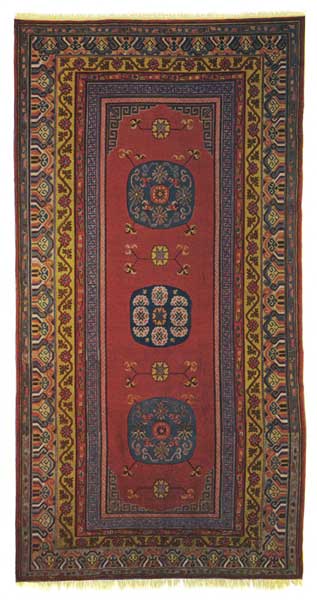
Size, 11.6 × 5.10
This is a fine specimen of the Samarkand rug. As usual in rugs of this class, the weaving is rather loose and the texture thin. The coloring is extremely rich and mellow. The field of red is in a warm tone, and the medallions are in fine shades of blue. One of the border stripes is a Chinese design. As in all rugs of this description, the Chinese element is plainly seen, both in design and color, showing what proximity of location will effect.[Pg 103]
View larger imageTekké-Turkoman rugs are sold in the Occident under the name of Bokharas. The design has little variety, and generally the rugs are among the easiest to distinguish. The design is usually octagon, in white or ivory tones with blue and orange, and occasionally green, upon a field of rich deep red, or rose. Brown and black, with white, are also used in the lines of demarcation or in the border. Sometimes the smaller designs are very decorative. Occasionally in the past this tribe, which is considered the most savage of all the Turkomans, has woven a rug with a diamond figure in place of the octagon, but this is not typical. Also instead of the usual red field a wonderful mahogany shade is seen with a rare green in place of the usual blue of the octagon. In the borders one often finds the eight-pointed star. The Tekké tribe use their rugs as portières, for divan covers, and for floor coverings. Rich in coloring, fine, yet durable, these rugs are greatly prized.
Yarkand rugs are very similar to Kashgar rugs, having the same general characteristics.
Yomud rugs are woven by the tribe bearing that name, whose territory seems to include both Astrabad and Khiva. The rugs woven by this tribe are in rich tones of deep red or plum, sometimes mahogany in tone. The design most frequently seen is the diamond, surrounded by the hook. The weaving is very[Pg 104] satisfactory, and the coloring in brownish-reds is particularly good. In some odd and rare pieces among the Yomud Turkomans, blue figures conspicuously, as does green also. The border in these rugs is sometimes in stripes, sometimes in a sort of crudely drawn vine.[Pg 105]
Caucasus is a general government belonging to Russia, and including Transcaucasia. The designs of the many rugs woven in this section of country are all parts of a system, and each design bears certain marks whereby its class may be identified.
Daghestan rugs are made in fine wools, and the mosaic designs are generally beautifully and skilfully done. The figures are nearly always geometrical, and in the form of diamonds, long octagons, lozenges, hooks, and small crosses. The colors of the best Daghestans are so well selected, that although there is no shading there is seldom anything aggressive or startling in the effect. Blues, reds, yellows, ivory, and other hues are chiefly used. The rug has a short, close pile, and although the texture is rather thin, the rug is very durable.
Derbent rugs, though woven at Derbent, the chief city of the province of Daghestan, differ somewhat from the Daghestans proper, being much softer and thicker. They are also more loosely woven, and have a longer pile. The designs are geometrical, several star devices often occupying the field; and here again we see the hook, which is a feature of the entire[Pg 106] Daghestan province. There is a good lustre in the Derbent rugs, and the coloring is often quiet and inconspicuous in dark blue, red, yellow, and ivory. Sometimes a soft pink is noticed.
Kabistan (Cabistan) rugs are woven at Kuba. They resemble the Daghestans to such an extent that they are often sold under that name. They have, however, more variety of design, although, as in the Daghestans, the diamond is generally a prominent feature, and often three large and many small diamonds are seen. The texture is firm, and the pile cut very close. Soft reds, greens, a delicate fawn, and browns are the usual colors. The borders may be in stripes, or with crude animal or bird devices. The antique Kabistan is very beautiful. Its texture is like velvet. Often one, and sometimes two borders contain the small single pink which is a most decorative floral ornament. The reds, light greens, ivory, and plum colors are arranged artistically, and quaint animal forms are often seen.
Karabagh rugs have characteristics of the other Caucasian rugs, but are more crude in coloring. Red is the chief color used. The rugs are coarse and quite crude in effect. The old-time rugs were vastly superior in workmanship.
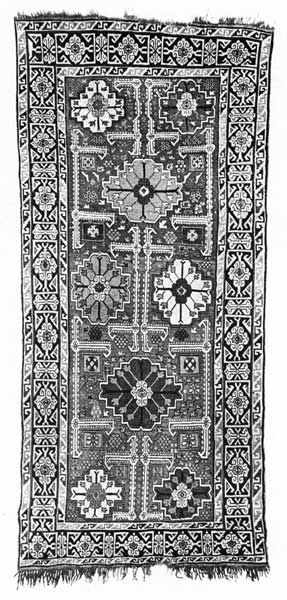
Size, 7 × 3.5
This rug has a fine texture and is straighter than most Daghestans. It is an antique, but its colors are as fast and clear as when it was first woven. It has been cleaned again and again, but nothing seems to dim its hues. The field of light blue is thickly studded with large and small geometrical figures in reds, yellows, and white. Some of the forms are in the lozenge design, with colors in red and yellow, the reds containing fine shadings of blue. Again square forms are seen, many holding the same colors, ornamented with contrasting but harmonious hues. In the centre are two geometrical figures of considerable size, one in yellow, and one in red. Each of these has yellow and white in its centre. On either side are still larger forms in yellow and blue. The border is geometrical, the hook design in a bracket being in evidence, and outside of this is a narrower stripe in red, white, black, and yellow. The many markings add greatly to the beauty of this interesting Daghestan.
View larger imageKazak rugs are woven by a nomad tribe dwelling among the Caucasus Mountains. There is a certain[Pg 107] strength and vigor about the Kazak rugs that seem to be in harmony with the tribe that weaves them. The word Kazak is a corruption of Cossack; and the durability of these rugs, as well as a certain boldness of effect in their designs and colors, corresponds with the hardihood of the people who weave them. The rugs are thick and soft; their colors are blues, soft reds, and greens. Often the field is a deep rose or a green, sometimes with one or more geometrical figures and several medallions, or with the palm-leaf design in rather large size throughout. When the palm leaf is used, it is generally decorated with a smaller leaf of a different hue. Many varieties of small designs are also seen, including circles, diamonds, squares, and the tau cross, which is almost always present. Some of the antique Kazaks are very fine.
Shirvan rugs are attractive from their quiet, agreeable tints, and fine, even texture. They are made in large quantities, and readily sold. The best are of white wool, but the inferior ones may hold cotton or goat's hair. Often blues and whites are the colors employed, with markings of red or yellow. Sometimes there are stripes in the border, one wide stripe followed by a series of narrow ones. The hook is a frequent design, and may be found in the field, incasing some geometrical figure. Sometimes a conventionalized floral design is observed in the border.[Pg 108]
Soumak rugs ought really to be called Shemakha, for that is the name of the town in the government of Baku from which they are exported. But the contraction of the word into Soumak is now universal. Erroneously too, these rugs are known as "Kashmir," for the sole reason that they are woven with a flat stitch and the loose ends left hanging at the back, just as they are in the old Kashmir shawls. The designs bear a resemblance to those of the Daghestans, and the hook is omnipresent. The best are durable, and sometimes a rarely beautiful Soumak is discovered, distinguished from the ordinary specimens by its soft hues and fine texture. One that I have in mind is of a rich blue field, with geometrical figures in terra cotta shades, and a rare bit of green in the way of ornamentation; the field of another is rose, and the geometrical forms are in deep blues, old blues, and ivory.
Tchechen (Chichi or Tzitzi) rugs are made by the Chichi nomads living among the mountains of Daghestan. The rugs have a strong resemblance to the Shirvans, and are often sold under that name. They are of about the same color and quality, but are wider. In the border there are frequently geometrical designs arranged between two or more stripes, and the tau cross is sometimes seen.
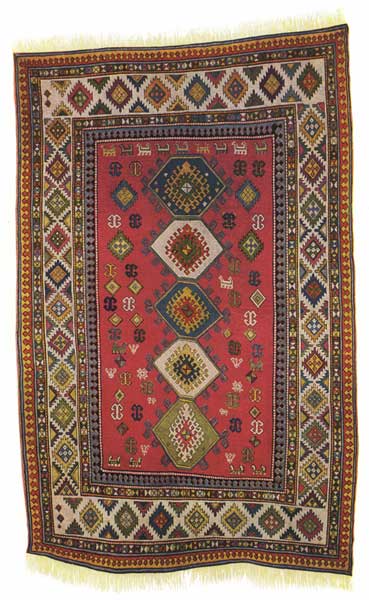
Size, 8.3 × 4.10
This is an unusually fine specimen of a Kazak rug. Its softness, combined with its solidity, gives it force and beauty. On the wonderful rose field a series of geometrical figures, five in number, are placed. Odd figures, including stiff little animals, fill in the remaining field. The wide border is composed of small diamonds, with varied forms of the hook design. The strength of the Cossacks is displayed in this hardy, forceful, and richly colored rug.
View larger imageNo rugs of importance are woven in Palestine. In several villages a coarse cloth is made which is waterproof because of its firm texture. It is used for cloaks or abas, and these are worn by all the men of the land. In Bethlehem is made the coarse cloth which is used as tent covering. This is produced from the sombre hair of the Palestine goat.
All Syrian rugs are made of pure wool, a home product of an average quality. Looms operated by machinery are unknown. The rugs are made in a primitive fashion by the peasant women and girls, who work at the looms in their own homes when not engaged in field labor or domestic duties. They also do the washing, dyeing, and spinning of the wool. The introduction of rug-weaving into Syria took place about the beginning of the nineteenth century, when a number of families emigrated from Brusa to villages of Syria, where they taught their art. For many years excellent rugs were woven, Haidamur especially taking the lead[Pg 112] in superiority of quality, design, and durability. Unfortunately, the original designs and blending of colors introduced from Turkey have entirely disappeared, and only inferior rugs are now made throughout the country. The chief colors in the modern Haidamur rugs are red and black, or sometimes crimson and black, with black or dark brown figures at each end. At Damascus a few rugs are woven, but not of any great value or distinctive beauty.[Pg 113]
The Chinese rugs of antiquity are remarkable, and worthy of the closest inspection. Their texture, designs, and symbolism show the greatest patience and thought. Antique wool rugs woven in China are very scarce, and because of this, and for their historical interest as well as their uniqueness and attractiveness, they bring large prices. In fact, they are almost unprocurable. A large and very fine specimen of this kind of rug is in the home of the late Governor Ames of Boston. It measures nineteen by twenty-one feet. The colors are yellow and white, and these are arranged in odd designs over the entire rug. A member of the family owning it writes: "This rug is said to have originally been in the Emperor's Palace in China. As every emperor is obliged to have the palace newly furnished when he succeeds to the throne, owing to some superstition connected with the retaining of any of the former Emperor's possessions, everything is removed and destroyed. Fortunately this rug escaped destruction." A fine example of an antique Chinese rug is represented in one of the illustrations of this book.
The modern Chinese rugs are vastly different from those of antiquity. There is, however, much of interest[Pg 114] attached to them. They are sought because of their antique designs, their harmonious coloring, and their durability. The monstrous and fantastic forms that distinguished the antique are not so frequently met with in the modern production. The predominating colors in a modern Chinese rug are yellow, blue, white, and fawn, and these are arranged very effectively. The designs are quaint and odd. A border distinctly separated from the field is almost invariably seen. A most important geometrical motif observed in Chinese rugs is the Meandrian, especially the continuous and that derived from the hooked cross. The hooked cross we find with rounded arms, generally in connection with a cloud band. The rosette from the vegetable motifs is very frequent, especially in borders; also the branch and the continuous creeper. Bats, butterflies, storks, and the goose are in many borders. The lion—symbol of a happy omen—is often represented in those rugs designed especially for wedding ceremonies.
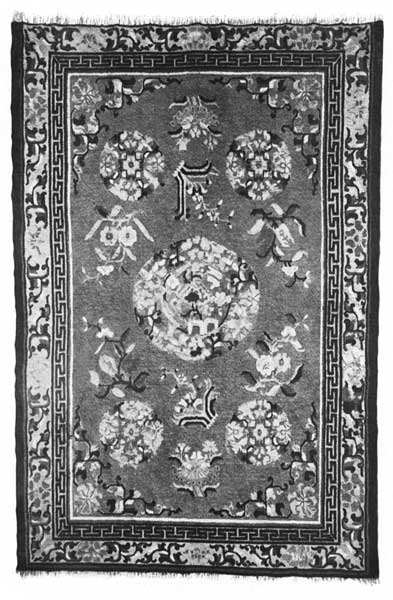
Size, 7.10 × 5.2
The modern Chinese wool rugs are not at all like this antique specimen, which was woven in Shantung about the year 1750. The material is wool, the pile is very thick and soft, and the texture, though loosely woven, is lasting. A large circular form in the centre of the field is richly decorated in a fine blue, yellow, and white floral design. Ivory is also seen in the markings, but no other colors are used except light yellow and a deep blue. The field is of a rare apricot hue, very unusual and beautiful. The border holds a Chinese fret design, the symbol of long life. This is in a rich deep blue, and the out-most part of it is in a dark shade of blue. The separate sprays of flowers on this rug represent the tea flower, which the Chinese use for decorative purposes, and the larger sprays hold the imperial flower.
View larger imageIn the northern part of China rugs are decorated with colored threads in crude imitation of figures; they are woven in sections, and then sewed together. Camel's hair of a coarse quality is used extensively by the Chinese for their rugs, and the laboring class use felts in their houses. These are cheap and durable, and are placed on the tiled floors so common in the colder parts of China.[Pg 115] The skins of the doe, deer, and fox are much used in China as rugs. These skins are sewed together in sections, according to various designs, and resemble mosaic work.
There are more circular rugs found in China than in any other country, and some are exported. But they are seldom called for in this country, and clerks in the large establishments which import them express surprise when inquiries are made for them. The warp of the ordinary Chinese rug is mostly of cotton, and the woof and pile are of wool or camel's hair.
Tsun-hua rugs are made of silk and camel's hair in the province of Chi-Li.[Pg 116]
In olden times woven rugs were not known in Japan. The wealthy classes of Japan covered their floors with grass, over which they spread the skins of animals. The poorer classes had not even skins, but only reeds or straw. About four hundred years ago silk and wool rugs were introduced into Japan from Persia, China, and India. For a time the Japanese imitated these rugs, but later the industry ceased. Since the opening up of the country, however, rug-weaving has prospered, and the introduction of fine cotton yarns of uniform quality has increased greatly the growth of all textile industries. The modern Japanese rugs are made of cotton or jute, and are used extensively in the United States in summer homes. In the towns which produce these rugs little children may be seen busily engaged in weaving, their small fingers being very deft at this work. The chief colors employed by the Japanese in their rug-weaving are blue, white, and sometimes a beautiful pink. In weaving, designing, and coloring, as in everything else the natives do, their exactness of finish and thoroughness in detail are noticeable. The Persian designs which were once reproduced in Japan are now supplanted by designs purely Japanese. The dragon is a favorite design in some of the older rugs.
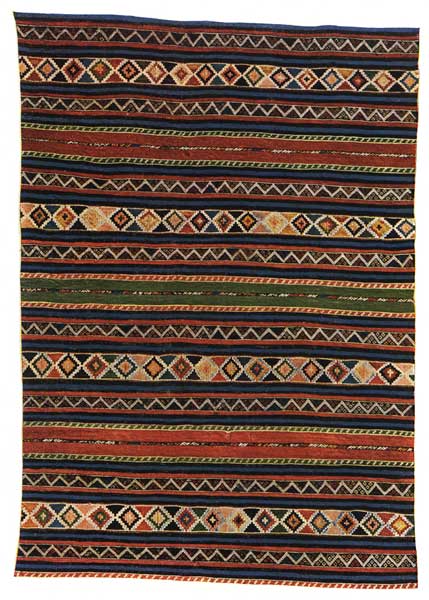
Size, 12.2 × 5.6
This is an unusually fine specimen of the antique Shirvan Khilim. Its hues are softened by time, and the contrasting colors are so carefully blended that the artistic effect is not lost. This Khilim has been carefully woven, and is firm and durable. The broad bands of apple green and other hues, interrupted by narrower bands, give a certain character and strength of appearance to this beautiful piece of Oriental workmanship. Some of the bands are embroidered with much skill.
View larger imageThe largest number of Khilims are woven in Turkish Kurdistan, although many are made in the adjoining territory, and at Sinna and Shirvan. They are also woven by the nomads of Anatolia and Merv, and Turkey in Europe now produces many Khilims, especially in the vicinity of Servia.
Khilims are made in different sizes, and are alike on both sides, with a smooth surface. Perhaps the Khilims most familiar to us are those which are long and narrow. But there are also smaller sizes, the smallest of all being called mats. All are without nap, and are woven with the flat stitch by the means of shuttles.
Karamanian is another name given to this decorative piece of tapestry. The Karamanian is woven in the tents of the nomad Yuruks and other Turkoman tribes. Occasionally this weave and the Kurdish have a mihrab at one end, showing it to be a prayer rug. The Sinna Khilims have a Herati design, and colors of green, yellow, and rose are frequent. The webbing at the end often contains a narrow stripe.
A bit of romantic sentiment is woven into the Kis Khilims, as those made by the Turks in Anatolia are[Pg 118] often called. It is asserted that the word means "Bride's rug," and that the name is derived from the fact that these rugs are woven by young girls, each of whom endeavors to finish her rug in time to win a husband. A lock of hair is often found in the Kis Khilim, said to have been woven in by the girl who made it.
In Oriental countries the Khilim is used as a floor covering, and also as a curtain to divide the dwelling portion of the tent from that in which the cattle are sheltered from the storm. It is also used by the natives on their journeys, and for general wear on the floors.
In the United States this fabric is exceedingly popular as a hanging, and for the cover of a divan it is equally effective, whether used in the home or in the studio.[Pg 119]
There are few of the so-called Polish rugs in existence, and these are priceless and cannot be bought. They are mostly seven feet long by four wide. The name takes its origin from the fact that a Pole (by name Mersherski), after travelling in Persia and India, established a rug factory in Warsaw.
Polish rugs are of silk, with gold and silver thread interwoven. Their texture is looser than that of the usual Oriental rug, and for this reason they cannot stand hard wear; but they are exceedingly handsome with their gold lustre and silky sheen. In these rugs a number of warp threads are crossed by the metal threads and overspread, so that the lines or ribs are brought out more prominently. This in part accounts for the softness and looseness of the texture.
Some time ago Dr. Wilhelm Bode, the eminent German scholar and authority on antique Oriental rugs, decided that these unusual rugs were of Persian origin, because of their general style and design. Since then Mr. R. Martin has proved this by documentary evidence.[Pg 120]
The prayer rug is so distinctly sui generis that it requires a little explanation. It is to be found wherever dwell the followers of Mohammed, and the design usually includes a representation of a mosque, or place of public worship, showing the mihrab, which is the niche in the wall of the mosque, so located that when the worshipper prostrates himself before it he will be prostrating himself toward Mecca.[A]
The Mohammedan, if he build a mosque, locates it so that its axis extends in the direction of Mecca; in such buildings the mihrab is not necessary, as the natural position of the worshipper places him so that his face is toward the sacred city. Where Christian buildings, such as the great Basilica of St. Sophia at Constantinople have been appropriated for Moslem worship, the niche or mihrab may be located well toward one corner of the building.
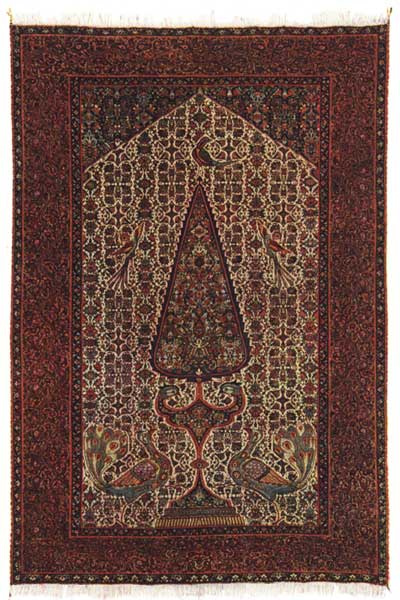
Size, 6 × 4.1
This beautiful and rare rug has an ivory field thickly studded with small floral designs woven most carefully. The knots are very closely tied, and the texture is soft and fine as velvet. A cypress tree occupies the centre of the field, and above its base on either side appears the head of a bird. Below there are two peacocks, in gorgeous plumage. The upper parts of the bodies of the peacocks seem actually to glisten like cloth-of-gold; silk threads appear in the tail feathers. At the top of the rug rests a bird of brilliant plumage, and on either side a bird evidently in the act of flying. The border of this fine rug is in stripes, the widest of a golden hue, with turquoise blue, light green, and soft reds in delicate tracery. The corner areas are deep and very minutely woven, corresponding perfectly with the field. Toward the centre of the corner areas and extending upward, is the mihrab, proclaiming for what purpose this rug was woven.
View larger imageThe prayer rug was evidently invented for the purpose of providing the worshippers with one absolutely[Pg 121] clean place on which to offer prayers. It is not lawful for a Moslem to pray on any place not perfectly clean, and unless each one has his own special rug he is not certain that the spot has not been polluted. With regard to the purity of the place of prayer Mohammedans are especially careful when making their pilgrimages, the rugs which they take with them having been preserved from pollution by being rolled up until the journey is begun, or until the hour of prayer arrives. It does not matter to these followers of Mohammed how unclean a rug that is on the floor may be, because over it they place the prayer rug when their devotions begin.
About two hundred years ago small embroidered rugs were largely made in Persia, chiefly at Ispahan. These were prayer rugs, and on each of them, near one end, was a small embroidered mark to show where the bit of sacred earth from Mecca was to be placed. In obedience to a law in the Koran that the head must be bowed to the ground in prayer, this was touched by the forehead when the prostrations were made, and so the letter of the law was carried out. The custom still prevails. The Persian women who make the finest prayer rugs seldom weave any other kind of rug. But the encroachments of civilization and commerce have changed the original purpose of the prayer rug. Once[Pg 122] it was sacred, and the masterpieces of workmanship in the products of Asia Minor were devotional in character. Upon these rugs many a soul prostrated himself before Allah in reverence; but now in the further interior only is the prayer rug made for aught but commerce.
As a class the modern Anatolian prayer rugs are quite inferior, being woven irregularly, and without regard to details or finishing; yet there are among them some fine specimens of Anatolian weaving. The famous prayer rugs of Asia Minor (Anatolian) made at Ghiordes, Kulah, Laodicea, and Meles are described in preceding pages. They are the joy of the collector and the artist. The antique Ghiordes rugs are really fine in colors, generally with much pale green, red, or blue. The design most frequently seen is the Tree of Life. One special kind is distinguished by a yellow vine on a dark blue field.
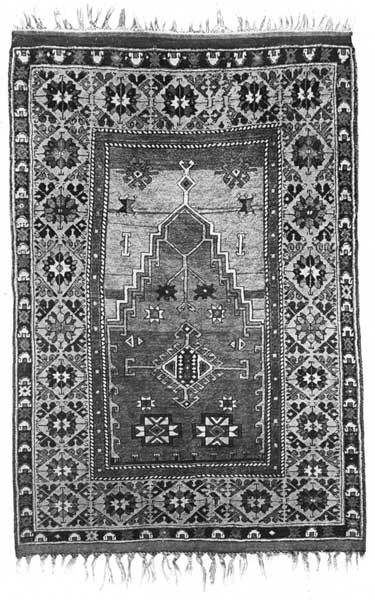
Size, 6 × 3.8
A deep, soft pile, firmness of texture, and superb coloring, characterize this rug. The lower section of the field is of cherry-red; the upper portion is a lighter shade of red, but blending perfectly, and forming by its shape at the top the niche which is characteristic of the prayer rug. This extends into the wonderful moss green of the upper section. The two tones (which appear exaggerated in the black and white plate) suggest the thought of a passing shadow upon a mossy bed. The red and green of the field are separated by heavy serrated lines of ivory, which unite at the top, leading up to and enclosing a small red lozenge, terminating beyond this in the hook design. It is in the centre of the lozenge that the Moslem places the stone or bit of earth when at prayer. Other hook designs and various geometrical forms are arranged upon the field. The wide stripe of the border is of a fine yellow, rich and lustrous, decorated in blue, green, and maroon devices. The outer border is in brown, and it is interesting to observe the series of nomad tents represented, each one worked in white wool, the entrances to the tents, however, being in reds, blues, or yellows. Alternating with each little dwelling are figures worked in red, blue, or green. This interesting rug is a product of Cæsarea.
View larger imageLong before other countries learned the art of cultivating silkworms, China was at work weaving fabrics of silk. Chinese historians claim that the origin of reeling silk and putting it to use was discovered by a woman,—Se-Ling-She, wife of Hwang-te, third Emperor of China,—and for that reason she has always been regarded by them as the "goddess of silkworms," The date of this discovery is about 2640 B. C. For about two thousand years the Chinese kept secret their methods of reeling and weaving silk, but finally Japan, Persia, and India learned the art, Persia having for many centuries transported raw silk between China and the West. Very slowly grew the process of silk-weaving. Greece, Spain, and Sicily by degrees attained the knowledge. In A. D. 550 it was introduced into Constantinople, and in 1148 silk manufacture was carried into Italy, and the cultivation of mulberry trees was enforced by law. The industry soon spread into the south of France, where it rapidly advanced.
At the present day enormous quantities of silk are produced in various parts of the world. The principal countries are China, Japan, India, Southern Europe, and some parts of Persia and Asia Minor. During the Middle Ages and down to the seventeenth century, the[Pg 124] province of Ghilan in Persia produced very fine silk and in large quantities. In all the countries and districts just mentioned, magnificent silk rugs have been woven for many centuries.
The silk rug when at its best is unsurpassed in beauty; it is distinguished by its richness, exquisite coloring, and rare sheen. But silk rugs require the most luxurious surroundings: nothing looks so out of place as one of these costly fabrics of the loom in a poor setting. They are more suitable for decorative purposes and museums than for service; they should be used as hangings, not for floor coverings. An exquisite silk rug interwoven with pearls is hung before the famous Peacock Throne of the Shah at Teheran, Persia.
The most magnificent silk rugs have been woven in China, and these are interesting from every point of view, especially as regards history, color, and texture. The silk rugs of Khotan are remarkable for their beauty and fineness; on important occasions of state and ceremony the Chinese place them upon the table. Silk carpets of special beauty worked with gold threads are made in Pekin for the Imperial Palace, although many of this kind found at the Court are said to be of Central Asiatic origin.
In making silk rugs, the greatest care is necessary in the shading. Sometimes the shading of woollen rugs is made more effective by the addition of silk.
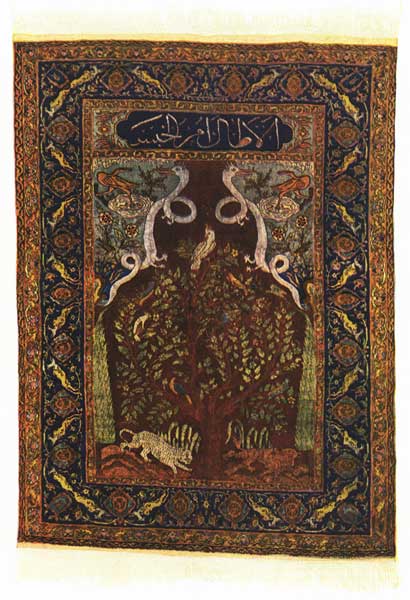
Size, 5.8 × 4.12
This remarkable rug in some lights suggests the heart of a forest. Some of its sections indicate Chinese inspiration, and recall, too, the famous Hunting Rugs. The field is in an unusual shade of reddish bronze, with a strong metallic lustre. In certain lights the surface looks like a mass of gleaming gold. In the centre stands the Tree of Life, its branches rich with foliage, among which birds of bright plumage seem to flutter. At the base of the tree two wild animals are depicted, apparently in search of prey. In the corner area at the top of the rug two serpents are attacking young birds in a nest, which is guarded by an agitated parent bird. On either side at the base of the rug is a cypress tree. Across the top is an inscription in Arabic.
View larger imageAs the demand for silk rugs is comparatively small, they are seldom woven on speculation. When made to order in Persia, they cost from ten dollars to fifteen dollars per square foot; thus the usual price of a silk rug of Persian make is from two hundred dollars up to thousands of dollars. Those made in Turkey can be bought much cheaper.
The Turkoman silk rugs are generally twice the size of the usual sheep's wool or camel's hair rugs. They are very fine, and often two hundred dollars is paid for a rug of this kind eight feet square.
Rugs made of raw silk are exported from Samarkand, and silk rugs of old Persian designs are copied and woven at Cæsarea. Some weavers of the modern silk rug, however, do not have recourse to established designs; they give play to their imagination, as do the weavers of wool rugs. Other weavers copy chiefly designs from chintz, and still others work from designs introduced from Europe.
Mrs. Bishop tells us that silk produced at Resht is brought to Kashan to be spun and dyed. Then it is sent to Sultanabad to be woven into rugs. It is next returned to Resht to have the pile cut by the sharp instruments used for cutting the velvet pile. After the rugs are finished, they are sent to Teheran to be sold.[Pg 126]
In the Orient a large and heavy rug is made of felt. This is used extensively by the natives, but is too heavy to export. Even the shepherds of the Kotan-Daria and of the Keriya-Daria use it in their primitive and isolated abodes. Sometimes an old felt rug is propped up by poles and becomes a tent, in which dwell the shepherds of Central Asia.
This felt rug is made of the hair of the camel, goat, or sheep, or by a mixture of all these kinds. It is matted together by heavy and constant pounding, moistened with water, turned and beaten again and again until it becomes compact and solid. Sometimes the felts are decorated with colored threads and often the name of the weaver is woven in. Among the best felts are those made at Astrabad and Yezd.
In color felts are gray, brown, or white. The last named are woven at Khotan. No dye is used; the hue is that of the hair of the animal, or the composite hue resulting from the mixture of the hair of different animals.
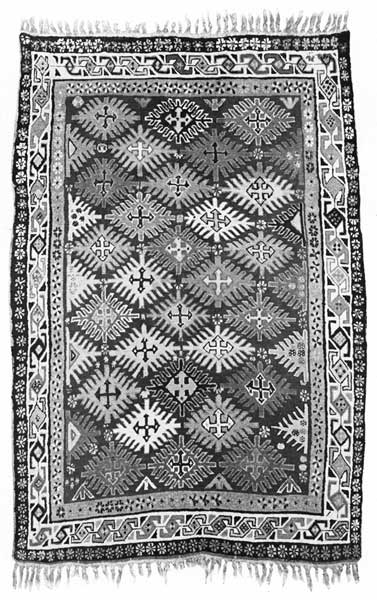
Size, 7.2 × 4.6
As a representative Derbent rug, this is an excellent example. It has the soft thick texture and long pile characterizing this product of the Caucasus. The entire dark blue field is covered with well-proportioned lozenge-shaped forms, distinctly outlined with serrated lines. Every centre has a cross of a color contrasting with the form containing it. The main border stripe is geometrical, with a variety of the hook design. Several floral devices are arranged in the maroon stripes on either side the wide one. There is a good deal of lustre to the rug, and the coloring is particularly charming in fine blues, soft rose, fawn, copper brown, subdued yellows, ivory, and rich green.
View larger imageThe felts have no seams, and are from one to four inches thick. Although this material is of far more ancient date than the days of St. Clement, a legend[Pg 127] connects his name with the discovery of felt. The tradition is that while on a pilgrimage the Saint, having put a wad of carded wool into his shoes to protect his feet from blisters, found at the end of his journey that the pressure and moisture had converted the wool into felt.[Pg 128]
The hunting rugs of Persia are the most remarkable and interesting rugs in existence. They had their origin in the Chinese pictures of hunting scenes, from which they were copied. They were undoubtedly made as early as the sixteenth century for the Shah. Exquisite in their weaving, marvellous in coloring, and of rare sheen, they are worthy of the closest attention. Nor is this their only merit; they serve as records of ancient customs, depicting the method of the chase, and portraying the mounted hunters in pursuit of the elephant, lion, phoenix, deer, and other creatures, fabulous and real. There are perhaps twelve of these precious rugs in existence. One, in silk, belongs to the Imperial House of Austria, another to Baron Adolphe Rothschild, a third is in the Palace at Stockholm, and a fourth, in wool, smaller than those mentioned, is in the possession of M. J. Maciet, Paris.[Pg 129]
[Pg 131]In the preparation of this section of this work, there has been no attempt or desire to slight in any way the weaving industry of the West. It has not seemed advisable, however, to go into many details on the subject, for it is one easily learned from many sources by any one who desires. There is not the mystery about Occidental weaving that there is about Oriental, the latter perhaps appealing to our innate desire of acquiring knowledge difficult of access. A short account of rug-weaving in Europe and the United States will, therefore, be quite as satisfactory to the general reader as a more lengthy description.[Pg 132]
Greek rugs are almost as ancient as Greece herself. Many an old love-song of this land has praised the skill of the woman deftly plying the hand loom. But if one expects to see the glory of ancient Greece, in its perfection of form and design, transmitted in any degree to the industry of modern rug-weaving he will be disappointed. From time immemorial rugs have constituted a most important part of the dowry of a young girl from the provinces. Even now the courting of a bride in Crete is often prefaced with the question whether the girl is skilled in the handling of a loom. But the modern Greek rug is seldom seen outside of its own country, for it is generally made for home use, and the weaver is not easily induced to part with it. Besides this, the foreign market would not be large for them, especially in competition with the well-known and excellent Oriental rugs.
Greek rugs are of two kinds—the heavy ones which serve for floor coverings in the winter, and the thinner, which are used all the year round. Both are made of home-produced wool, often with hemp woof, and are worked by women and girls only, in wooden looms of a primitive order.[Pg 133]
Athens is the only place in Greece where rugs are produced in a factory. Under the patronage of Her Majesty the Queen, an Association for the Education of Poor Women exists. This philanthropic association has founded an industrial institution which employs four hundred women and girls in its various departments, of whom about thirty are engaged in rug-weaving. The best rugs are those purely Grecian in design and quality, and for these special orders are generally sent in. The rugs thus woven are durable and effective. Sometimes an attempt is made to imitate Turkish rugs, but without their superb effect. Coarse rugs of an inferior class are sold in the bazaars of Athens. The predominant color in these is a dingy white, with stripes of various colors at the ends. The rug is really durable, though the noticeable, fuzzy nap soon wears off.[Pg 134]
The Arab conquerors of Spain, or the Moors as they are often called, are believed to have taught the Spaniards and Venetians the art of rug-weaving. The rugs now known as Moorish are made by the descendants of this race. Their leading color is yellow, and in style and quality they resemble the so-called Smyrna rug. Antique Moorish rugs are found in the cathedrals of Toledo and Seville. These are relics of the thirteenth century and have geometric designs.
Morocco rugs are Moorish. Those of modern manufacture are very inferior. The poorest aniline dyes are used, and it seems hardly possible that the splendid specimens of the fourteenth to the end of the seventeenth century were woven in Morocco. But the rugs in the Sultan's palace at Fez prove this fact, as does the splendid antique rug in the possession of Prince Schwarzenberg, at Vienna. Fez was formerly one of the chief seats of the rug industry, which is now limited mostly to Rabat. Unfortunately, aniline dyes are now largely used, and even the designs are less artistic than in former years. There is, however, a rug not known to the trade, and only rarely met with outside its home. It is the[Pg 135] Tuareg rug, and is woven by the Berbers, a tribe occupying the desert south of Algeria and Tunis, and known as Tuareg or Tawarek by the Arabs. The Tuaregs are great traders, and control the principal caravan routes. Their rugs are woven by the women, and seldom if ever leave the families which weave them. The most beautiful are used as shrouds, and are buried with their owners.
Tunis sends out a few rugs woven at Kairuan. They are thick, heavy, but inferior in many ways to rugs of Oriental workmanship.[Pg 136]
Bosnian rugs in olden times were sometimes very fine. Then came years of general depression, when the industry of weaving fell into decay. Finally the Austro-Hungarian administration was established at Bosnia, and new life was given to the work. Looms were erected by the Government, and a number of women were sent to Vienna, where they were taught the art of weaving. Returning to Bosnia, they were able to impart to others the knowledge they had gained, and thus the work prospered. To enhance further the value of these rugs, the latest designs in the old Bosnian rugs were selected, and by the harmonious blending of these with new designs and colors, modern rugs were made, which show decided improvement.
Servian rugs are woven throughout all Servia, but the principal seat of the industry is at Pirot, on the southern boundary of the Balkan Mountains. The rugs are of wool, and the best are very durable. The dyes are generally vegetable, the weaving is a home industry, and the designs are all worked on a black or red ground. The preferment in the modern rug is for red,[Pg 137] but the older rugs had the black ground. The general design is an extended square, in the centre of which is a panel. The rest of the field is filled with stripes and geometrical forms in rather bright and varied coloring.
Roumanian rugs of modern make are quite inferior. They are woven on ordinary hand looms in the villages and towns among the mountains of Roumania. They are coarse, and the designs are in stripes, zigzag lines, or straight-lined figures. Occasionally flower designs have appeared, but these have been poorly reproduced, and in the most unsuitable combinations of color. Old Roumanian rugs are not in the market. They are owned by private individuals, and are not to be procured except at very high prices, if at all. These rugs differ from the modern ones in their better workmanship and designs.
Bulgarian rugs, as a rule, are very coarse in texture, loosely woven, and unattractive. Occasionally Bulgarian rugs are seen with finer weaving and well-chosen colors. Both men and women take part in preparing the wool, the former setting up the simple looms, preparing the darker dyes, and arranging the warp. The women choose the designs and colors, and weave the rugs. The colors commonly used are yellow, blue, brown, black, white, green, and red.[Pg 138]
In England the introduction of tapestries as hangings for walls was made by Eleanora, sister of Alfonso the Tenth of Castile, when she became the wife of Edward the First. In her journeyings these fabrics of the loom were carried as part of the royal baggage, and must have given some sense of cheer, particularly when they clothed the bare walls of the dreary castle of Cærnarvon.
Edward the Third (1327-1377) invited Flemish weavers to settle in England. At that time England produced wool in large quantities, although very few fabrics were woven there, nine-tenths of the wool being sent to Ghent or Bruges to be manufactured; for the Flemish were the first people in the northern part of Europe who advanced in the arts and in manufactures. Throughout Northern and Western Europe rugs were seldom used, except for wall hangings and table covers, until the time of the Reformation in Germany.
Great Britain is now quite active in the manufacture of rugs with certain designs, a decided impetus to the improvement of this industry being given by Mr. William Morris, the English poet and artistic decorator, who was born near London in 1834.
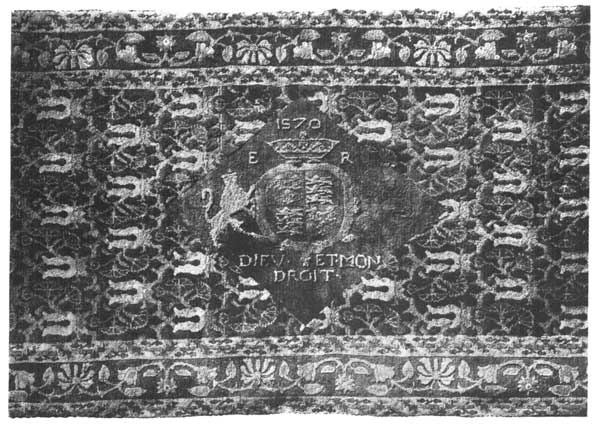 EARLY ENGLISH RUG
EARLY ENGLISH RUG
Centre portion of a carpet woven in wool, with a continuous pattern of carnations, and a border of wavy floral design. In the diamond-shaped panel of the centre are the Royal Arms and the letters E R (Elizabeth Regina).
View larger imageThe Morris Rug. With strong, firm texture, fine vegetable dyes, and with purely artistic designs, the Morris rug bears testimony to-day to the honesty, perseverance, and skill of the man for whom it is named. He himself testifies: "I am an artist or workman with a strong inclination to exercise what capacities I may have—a determination to do nothing shabby if I can help it." Decorative art in many branches is the richer to-day for the influence of Mr. Morris, but it is his rug-making that now claims attention. Mr. Bernhard Quaritch informs me in a letter dated August 31, 1899, that Mr. Morris learned the art of making rugs from a volume of the work entitled "Descriptions des Arts et Metiers." Mr. Morris had his own loom, and not only wove rugs, but dyed the wool for them himself, and instructed pupils, to whom his inspiration was a power. Long and laboriously he worked to achieve the best results, using vegetable dyes only, and he was finally successful. No dyer of the Orient could have been more pleased than was he when his efforts resulted in soft, glowing tints.
In design Mr. Morris excelled. He educated the popular taste by bringing forth the beauties of the simpler forms of the floral and vegetable world; he delighted especially in displaying the acanthus in varied conventional forms. Every rug he designed bears[Pg 140] witness to his enthusiasm for harmony. Too æsthetic, some critics declare him to have been; but no one can deny the importance of his creations, for England needed to be awakened to a knowledge of her own inability to appreciate artistic decoration of the home, especially by means of the productions of the loom. It was this very fact, and his inability to procure artistic furniture such as would satisfy his æsthetic taste, that started Mr. Morris to create those fabrics which he desired.[Pg 141]
The art of rug-weaving was first introduced into the West by the Moors when they conquered Spain. With the advance of civilization it proceeded to the land of the Gauls, where during the reign of Henry the Fourth it was brought from Persia. An inventor named Dupont was placed in charge of a workroom by the King, in the Palais du Louvre about the year 1605. In the year 1621 an apprentice of Dupont's, named Lourdes, was instructed to establish the industry of weaving in a district near Paris, where was the Hospice de la Savonnerie, an institution for poor children. The factory was called La Savonnerie because the building had been previously used for the manufacture of soap. Since 1825 La Savonnerie has been consolidated with the Gobelins manufactory. In 1664, Colbert, minister to Louis the Fourteenth, founded the establishment at Beauvais which is owned by the French Government, as is also that of the Gobelins, which Colbert bought of the Gobelin family. But it is to the Saracens that France ultimately owes the origin of her famous tapestries, and it is to the Saracens, through France, that Western and Northern Europe trace their obligation.[Pg 142]
The industry has attained large proportions in France. At Aubusson alone over two thousand work-men are employed in rug-weaving. A fine specimen of the work done there is a rug of Oriental design made for a collector in New York. The piece-work system is now generally used throughout the weaving districts of France. The manufacturers themselves usually place the rugs on the market. France buys the greater quantity, although many are exported.
Austria-Hungary, Germany, Holland, and Italy have also had some experience in rug-weaving, and even little Switzerland at one time attempted its introduction, but with unsatisfactory results. Belgium, however, was more successful, for Brussels still produces a large number of rugs.[Pg 143]
The United States is largely occupied in rug-weaving, and the centre of the Eastern section of this manufacture is Philadelphia. But in various sections of the country there are rug factories, both large and small.
The Abenákee rug is made at Pequaket, New Hampshire. It is the result of a desire on the part of Mrs. Helen R. Albee to give profitable employment to the women of the rural community where she lives. Her success is now assured, and the reward for much labor and thought has come in a lively demand for the rug.
The Abenákee rugs are not woven. They are an evolved form of the much despised New England hooked rug, which was made by drawing strips of old rag through burlap. The thick, soft, velvety Abenákee rugs of the present day are far removed in color, design, and texture from their humble ancestors. These rugs are all wool, hand-dyed in warm tones of terra-cotta, old rose, old pink, tans, dull yellows, rich old blues, olive and sage greens, and old ivory. They are made to order usually, to match in their ground color some special color in the room where they are to be placed, and the borders are made in harmonious tones. The[Pg 144] range of design is wide, from Oriental to Occidental—from Japanese to North American Indian. But all suggestions, so soon as received, are modified and removed as far as possible from direct imitation of any foreign rugs. Mrs. Albee has aimed, not to reproduce Oriental effects, but to have the designs original and distinctive. Fortunately, for years previous to the establishment of this industry, she had studied the principles of design and their application to various textiles, and the knowledge which she thus acquired has proved most valuable.
The designs are bold and effective, but fineness of detail is precluded by the strips of material, each of which is a quarter of an inch wide. The color is arranged in broad masses.
The New England Hooked or Rag rug has for its foundation a strip of burlap or sacking. Through this, strips of cloth are hooked, which form loops, and this surface may be sheared or not, as the maker desires. There is such an absence of attractiveness in the old-time rag rug, that several women of taste and experience in art methods have sought the improvement of this industry. The results have been excellent, so that, ugly as the original rug is, it is esteemed as being the progenitor of the more artistic Abenákee, Sabatos, and Onteora rugs.[Pg 145]
The Sabatos rug is a product of the little mountain village of Center Lovell, Maine, started in 1900 by Mrs. Douglas Volk of New York. She has now about a dozen women engaged in the work, this number including the spinners, dyers, and weavers.
The Sabatos rug is durable, harmonious in color and design, and is distinctly a home product. The wool of which it is made is sheared from the flocks of sheep in the vicinity. The shearing takes place annually in June; the wool is then carded, spun, and dyed. The threads of hand-spun wool are worked through a hand-woven webbing, and securely knotted or tied with a specially devised knot. The designs thus far are mainly adaptations from the native American Indian motives, which are simple and characteristic, furnishing a chance for broad color effects.
A special point is made of the dyes employed, those of vegetable origin ruling, and only those dyes which from experience have been found to be practically fast are used,—such for instance as genuine old Indigo blue, madder root, and butternut.
Berea College, Kentucky, is endeavoring to encourage the weaving of rag rugs of a superior order. So far, the industry which was started in 1905, is in a primitive state, the natives preferring to weave cotton and wool coverlets, the designs of which they brought[Pg 146] across the mountains with them from Virginia in the early settlement of Kentucky. Floor rugs they consider troublesome. The weaving is carried on in the homes throughout the mountains of that region known as "Appalachian America"; it is really a survival of the old Colonial industry. The rugs are woven of strips of new ticking, and are especially designed for bath-rooms, children's nurseries, and porches. The coloring is done with the vegetable dyes and native barks and roots. The color schemes are the simple ones of a primitive people.
Navajo Rugs. The Navajo Indian Reservation covers about eleven thousand square miles, about six hundred and fifty of which are in the northwest corner of New Mexico, and the remainder in the northeast portion of Arizona. The region is well adapted for the raising of sheep, and every family possesses flocks, which are driven from place to place for pasture. The Navajos, however, never go to any great distance for this, but keep generally within a radius of fifty or sixty miles from home. This tribe weaves a rug that is useful, unique, durable, and when at its best, impervious to rain. Among the tribes, and in some Western homes, they are used as blankets, but it has become a fashion in many of the best houses in the Eastern States to use them entirely as rugs, couch coverings, and portières.
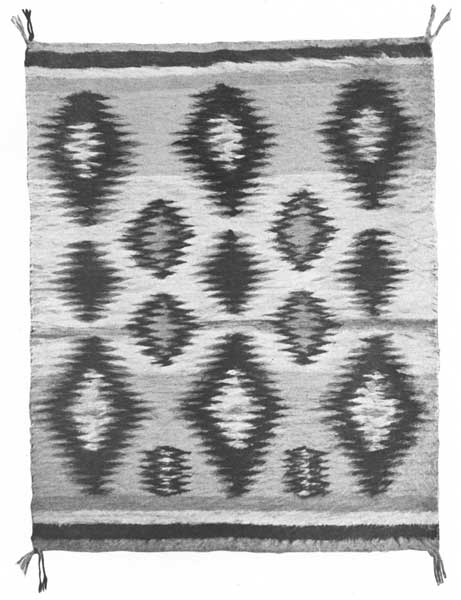
Size, 3.9 × 4.9
The field of this Navajo Rug is in a natural shade of grayish white. Six large diamond forms in black, with reddish edges and white centres, rest on the field. The centres contain a tiny red line, and there are smaller diamonds—seven in number—four having red centres and the remainder black, and at one end are two small figures. The border is in stripes of red, black, and an addition of white. The rug is a fine sample of the American Indian weaving, and its simplicity places it in striking and pleasing contrast to many of the modern productions of the Navajos.[Pg 147]
View larger imageIt is believed that the Spaniards, when they arrived in that section of North America inhabited by the Pueblo tribe of Indians, communicated to them the industry of weaving these rugs, and that the Pueblos taught it to the Navajos. Thus it appears that the weaving of the Navajo rug was a result of the Moors' invasion of Europe. The sheep, which are raised by thousands, were also introduced by the Spaniards. The wool is not washed until after the shearing. In the last quarter of the nineteenth century the Navajos began to use the shears of the white man; previously they procured the wool by cutting it off the body of the animal with a knife, and pulling it from the legs.
The native dyes are red, yellow, and black, and the natural colors of the wool are black, gray, and white. The dyes of the white man are now much used. Formerly there was a beautiful blue, which has given way to the indigo. A scarlet cloth called Bayeta was once much used in the weaving of these rugs, but Germantown yarn and other inventions of the white man have largely superseded the old-time materials and methods.
The spindle is of the crudest form, and sometimes the wool is simply picked out from the mass, and rolled into the yarn or thread on the hand.
The looms are fashioned after the most primitive[Pg 148] ones of the Orient, and the weaver sits on the ground and weaves upward. Women do most of the weaving, but occasionally a dusky-faced man may be seen at the loom. It takes about a month to weave a rug six feet ten inches by five feet seven inches.
The designs in the Navajo rugs are many, and mostly in angles and straight lines, the serrated diamond design being common, as is the swastika or fylfot. The weaver makes up her own designs as she goes along, occasionally only tracing it in the sand.
There is a symbolism attached to many forms in these rugs. The square with four knit corners represents the four quarters of heaven and the four winds. A tau cross is a symbol of protection and safety, and a prayer to the Great Spirit. A spiral form represents the purified soul, and a double spiral is a symbol of the soul's struggle. A wave mark represents the sea, over which the people came from a far country. Black is the symbol of water, regarded as the mother or spirit. Red is the symbol of fire, and is regarded as the father.
The native costume of the women of the Navajo tribe consists of two small rugs in dark blue or black, with a bright stripe at each end. They are of the same size, and sewed together at the sides, except where a place is left open for the arms. Formerly the Indians[Pg 149] reserved their hand-made rugs for their own use, but now that there is so great a demand for the work of their hands, they sell those rugs, and content themselves with blankets of factory make.
Old Navajo rugs, like Oriental ones, are growing scarcer every year, and naturally are becoming more valuable and desirable. The fine textures, perfect workmanship, and glowing colors are seen at their best in productions of the past.[Pg 150]
[Pg 153]We are occasionally indebted to an Oriental scholar for a translation of an inscription on a rug; often these inscriptions show the religious belief of the maker.
One fine rug in a museum in Austria has the following inscription: "Allah! No God exists besides Him, the Living, the Eternal. Nothing causes Him to slumber or to sleep. To Him belongs everything in heaven and on earth. Who can intercede with Him without His permission? He knows what is before and what is behind, and only so much of His wisdom can be grasped as He permits. His throne fills heaven and earth, and the support of both to Him is easy. He is the High One, the Exalted!"
A rug of Persian weave owned by Baron Nathaniel Rothschild has, worked in the oval cartouches, an inscription translated by Professor F. Bayer as follows:[Pg 154]
1."Honored mayst thou be in the world,
Among the clever and wise.
2. May no sorrow be allotted thee by an unfavoring Heaven,
And may no care torment thy heart.
3. May earth be all to thee that thou wouldst have it, and destiny prove thy friend.
May high Heaven be thy protector.
4. May thy rising star enlighten the world,
And the falling stars of thine enemies be extinguished.
5. May every act of thine prosper,
And may every year and every day be to thee Spring-time."
In the Industrial Museum at Berlin there is a rug with this inscription: "There is no Deity but God, and Mahomet is His Prophet."
On a Persian silk rug is a line from the Koran: "All perisheth but His face."
Another rug has: "God is greatest! He is great!"
Often a marking in a corner of a rug is simply the name of the maker, and the date.
The Holy Carpet of the Mosque at Ardebil, now in the South Kensington Museum, at London, has the following interesting inscription woven in black characters in the light cream cartouche at the top of the carpet. Translated it reads:[Pg 155]
"I have no refuge in the world other than thy threshold.
My head has no protection other than this porchway.
The work of the slave of this Holy Place,
Maksoud of Kashan
In the year 946."
(The year 946 of the Hegira corresponds to A. D. 1568.)[Pg 156]
All Oriental rugs have designs, and every design is symbolical. To the connoisseur, as well as to the owners of rugs, it is vastly interesting to understand the meaning attached to these symbols by the Orientals. Every one is familiar with the tree design in some of its various forms, and with the stiff little birds and the many odd and strange-looking animals which frequently are seen on an Eastern fabric of the loom. Yet each unique figure has a meaning, and it is a fascinating, as well as an apparently endless task, to find the hidden significance of these symbols. If one goes no further, he should at least become familiar with the designs on his own rugs, and know, if possible, what they typify.
The rug itself symbolizes Eternity and Space, and the filling or plan is the symbol of the world—beautiful, but fleeting and limited.
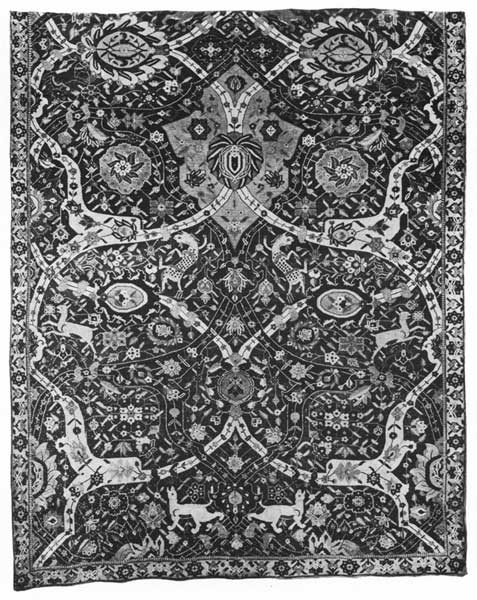
This rug dates from about 1500 A. D., and is of wool, with animal and floral forms.
View larger image| Bat | Happiness. |
| Buddhist Sceptre | Success in literary labors. |
| Chi-lin (a kind of doe) | Nobleness; gentleness. |
| Cloud-band | The Deity. |
| Cock and hen on an artificial rock-work | Pleasures of country life. |
| Crane | Immortality. |
| Crow | Evil. |
| Deer | Official emolument. |
| Dragon | The imperial emblem, signifying increase and imperial grandeur. |
| Dragon with five claws on each of its four feet | Exclusive emblem of the Emperor. |
| Dragon and Phœnix | Newly wedded pair. |
| Duck | Conjugal affection. |
| Goose | Domestic felicity. |
| Gourd | Happiness. |
| Lion | Victory. |
| Magpie | Good luck. |
| Old man leaning on a staff | Long life. |
| Owl | Dread. |
| Peach | Old age. |
| Phœnix | The Emblem of the Empress. |
| Stork | Long life. |
| Tortoise | Long life. |
| Tree of Life with seven branches on a short stem | Seven days of Creation. |
| Young stags | Long life. |
| Asps | Intelligence. |
| Bat with a ring in its claws | Duration. |
| Bee | Immortality. |
| Beetle | Earthly life and the development of man in the future state. |
| Blossom | Life. |
| Boat | Serene spirit gliding upon the waters. |
| Bull | Source of life. |
| Butterfly | Soul. |
| Cartouche | Eternity. |
| Crescent | Celestial virgin. |
| Crocodile | Beneficent Deity. |
| Dove | Love; mourning of a widow. |
| Eagle | Creation; preservation; destruction; power. |
| Egg | Life. |
| Eye of Osiris | Eye of the Eternal Judge over all. |
| Feather of an Ostrich | Truth; justice. (The ostrich itself does not appear In Egyptian art.) |
| Feathers of rare birds | Sovereignty. |
| Frog | Renewed birth. |
| Hawk | Power. |
| Ibis | Usefulness; the heart. |
| Lizard | Divine wisdom. |
| Lotus | The Sun; creation; resurrection. |
| Nile Key | Life. |
| Palm tree | Immortality; longevity. |
| Papyrus | Food for mind and body. |
| Pine cone | Fire. |
| Pomegranate | Life. |
| Rosette | A lotus motive. |
| Sail of a vessel | Breath; the belief that the soul is inactive and worthless until revived by the breath of the mind. |
| Scarabæus | Immortality; resurrection; a ruling providence. |
| Solar disk with serpents | Royalty. |
| Sphinx | Beneficent Being. |
| Staff in the hands of the gods | Purity. |
| Sun | Deity; life. |
| Viper | Power. |
| Wheel | Deity. |
| Zigzag | Water. |
| Ass | Humility; austerity. |
| Banian or Burr Tree | Deity (because of its outstretched branches and overshadowing beneficence). |
| Butterfly | Beneficence of Summer. |
| Fylfot cross of Buddhism | Auspiciousness. |
| Knot and flower design | Divine bounty and power. |
| Serpent | Desire. |
| Pine trees | Long life. |
| Storks | Long life. |
| Tortoises | Long life. |
| Descending Eagle | Bad luck. |
| Eagle | Light; height. |
| Flying Eagle | Good luck. |
| Hounds | Fame; ever increasing honor. |
| Leopards | Fame; ever increasing honor. |
| Lion | Power; victory. |
| Peacock | Fire; light. |
| Phœnix | Immortality. |
| Standing Eagle | Good luck. |
| Sun | Light. |
| Sword | Force. |
| Tree of health | Immortality. |
| Tree of life | Knowledge; truth. |
The Coat of Arms of Persia is the Lion holding a sword in his paw, and with the Sun at his back.
| Crescent | Increasing power. |
The Turkish Coat of Arms is the Crescent and the Star. These heavenly bodies are supposed to signify growth.
| Anemone | Good fortune. |
| Bat | Maternity. |
| Bird | Spirit. |
| Boar | Winter. |
| Butterfly | Ethereal soul. |
| Circle | Eternity; perpetual continuity. |
| Cypress tree | Tree of life; immortality; perfect and renewed life. |
| Dog | Destruction; vigilance. |
| Elephant | Patient endurance; self-restraint. |
| Evergreens | Immortality. |
| Fir Cone | An existence terminated but united--the union of the tribes against the dominion of Rome. |
| Fly | Destroying attribute. |
| Hare | Fertility. |
| Heart | Man morally. |
| Hippopotamus | Destroying power. |
| Hog | Deep meditation. |
| Jug | Knowledge. |
| Lily | Purity. |
| Olive | Consecration to immortality. |
| Owl | Wisdom. |
| Ox | Patience; gentleness. |
| Peacock | Resurrection (because of the annual renewing of its plumage, and from a belief in the incorruptibility of its flesh).[Pg 161] |
| Phœnix | Good luck; herald of prosperity; birth of great men. |
| Pig | Universal kindness. |
| Ram | Spiritual leadership. |
| Reed | Royalty. |
| Rhinoceros | Religious recluse. |
| Scorpion | Invincible knowledge. |
| Serpent | Life; immortality. |
| Spear | Destructive power. |
| Spider | Slave of passion. |
| Squirrel | Averter of evil. |
| Stars | Divinity. |
| Swastika | Good fortune. |
| Turtle | Constancy. |
| Wheel | Universe. |
| Wings | Spontaneous motion. |
| Wolf | Destroying power. |
| Akhissar | White Citadel. |
| Bagdad | Abode of Peace. |
| Baku | Place of Winds. |
| Beluchistan | Land of the Beluchis. |
| Bhagulpore | Tiger City. |
| Bokhara | Treasury of Sciences; the Noble. |
| Deccan | The South Land. |
| Derbent | Fortified Gate. |
| Fars | Land of the Farsi or Persians. |
| Fu-Chau | Happy City. |
| Gilan | The Marshes. |
| Gulistan | The Rose Garden. |
| Haiderabad | Gate of Salvation. |
| Herat | The Pearl of Khorassan; the Gate of India. |
| Islamabad | Abode of Islam. |
| Ispahan | Place of Horses. |
| Jerusalem | Heir of Peace. |
| Kandahar | Key of India. |
| Karabagh | Country of the Sun. |
| Kara Dagh | Black Mountains. |
| Kelat | Castle. |
| Khorassan | Land of the Sun. |
| Kwatah | Citadel. |
| Mecca | The Heart of Islam; the Holy City. |
| Meshed | Tomb of a Martyr. |
| Mirzapore | City of the Emir. |
| Ning-po | Peaceful Wave. |
| Peshawar | Advanced Fortress. |
| Samarkand | The Head of Islam. |
| Shang-hai | Approaching the Sea. |
| Srinagar | City of the Sun. |
| Tabriz | Pinnacle of Islam. |
| Teheran | The Pure. |
| Yezd | City of Light; City of Worship. |
Owing to the variety of ways in which the names of Oriental localities are spelled when transliterated, it is extremely difficult to establish a standard of spelling. Many curious examples of this occur both on maps and in dictionaries. It is certainly confusing to open an atlas that is supposed to be an authority, and find that the name one seeks differs in spelling from that used in the atlas first consulted. Then by looking into dictionaries it is found that each of these has a different way of spelling the word sought. Then turning to a guide book of the country there will probably be found not only another combination of the letters, but also a conflict between the descriptive matter in the book and the map accompanying it. When books of travel are consulted, the embarrassment is still further increased.
After having accepted a mode of spelling geographical names for use in this volume, I propose in the pages that follow to assist the reader to locate the places mentioned, by assigning them to their respective countries, so that at a glance he may identify them. This classification will also be a key to the map.
Occasionally the name of a place has been inserted which is not rug-producing, but only a mart for the selling of rugs. This has seemed advisable as the names are intimately associated with the rug industry.
Afghanistan
Beluchistan
Chinese Empire
Province of East Turkestan
India
Japan
Persia
Russian Empire
| } | Daghestan. | |
| Caucasia. | Derbent. | |
| Kuba. |
| } | Karabagh. | |
| Transcaucasia. | Shemakha. | |
| Shirvan. |
Central Asia
Turkey in Asia
Africa
France
Greece
A
B
C
D
E
F
G
H
I
J
K
L
M
N
O
P
Q
R
S
T
U
W
Y
Z
Allen, J. Rowelly: Early Christian Symbolism.
American Journal of Archeology.
Ashenhurst, Thomas R.: Design in Textile Fabrics.
Auber, M.L., Abbé: Bible Myths.
Babelon, Ernest: Manual of Oriental Antiquities.
Ball, J. Dyer: Things Chinese.
Birdwood, Sir George C.: The Industrial Arts of India.
Bishop, Mrs. Isabella L. Bird: Journeys in Persia and Kurdistan.
Bishop, Mrs. Isabella L. Bird: Unbeaten Tracks in Japan.
Blackie, C.: Dictionary of Place Names.
Bode, Wilhelm: Vorderasiatische Knüpfteppiche.
Bonnick's Egyptian Belief and Modern Thought.
Brummer, Martin: Egypt, Three Essays on the History, Art, and Religion.
Budge, E.A. Wallis: The Mummy Badge.
Century Atlas, The.
Century Dictionary, The.
Chambers's Encyclopædia.
Clarke, Sir C. Purdon: Oriental Carpets. (English Edition. Published by the Imperial and Royal Austrian Commercial Museum. Vienna, 1892.)
Constable's Hand Atlas of India.
Coxon, Herbert: Oriental Carpets.
Curson, Hon. George N.: Persia and the Persian Question.
Davis and Cobern: Ancient Egypt.
Denny, M.B.: The Folk Lore of China.[Pg 176]
Dresser, Charles: Carpets.
Edwards, Amelia: Third Lecture, Pharaohs, Fellahs, and Explorers.
Elkins, Joseph, D.D.: Ancient Symbolism among the Chinese.
Ely, Talfourd: Manual of Archæology.
Emmaus's Life in Ancient Egypt.
Evans, E. P.: Animal Symbolism in Ecclesiastical Architecture.
Faber, George Stanley: Origin of Pagan Idolatry.
Fergusson, James: Tree and Serpent Worship.
Fusenbeth, F. C., D.D.: Emblems of Saints.
Goodyear, William H.: The Grammar of the Lotus.
Hedin, Sven: Through Asia.
Hulme, F. Edward: Symbolism in Christian Art.
Iconographic Encyclopædia of the Arts and Sciences.
Inman, Thomas, M.D.: Ancient Faiths.
James, A. G. F. Eliot: Indian Industries.
Jones, Owen: The Grammar of Ornament.
Journal of the Society of Arts.
Karabacek, Dr. Joseph: Die Persische Nadelmalerei.
Knight, Richard Payne: The Symbolical Language of Ancient Art and Mythology.
Landor, A. Henry Savage: In the Forbidden Land.
Layard, Austen Henry: Discoveries in the Ruins of Nineveh.
Layard, Austen Henry: Nineveh and Babylon.
Layard, Austen Henry: Nineveh and Its Remains.
Lenormant, François and Chevalier, Charles: Manual of the Ancient History of the East.
Lessing, Julius: Oriental Carpets.
Lübke, Wilhelm: History of Ancient Art.
Malcom, Sir John: History of Persia.
Marvin, Charles: Merv, the Queen of the World.
Maspero, Gaston C. Charles: Manual of Egyptian Archæology.[Pg 177]
Maspero, Gaston C. Charles: Dawn of Civilization.
Meyer's Handbook of Ornament.
Mumford, John Kimberly: Oriental Rugs.
Müntz, Eugene: A Short History of Tapestry.
O'Dagree, H. Eugene: Les Symbols Antiques.
O'Donovan, Edmund: The Merv Oasis.
Perrot, Georges and Chipiez, Charles: History of Art In Ancient Egypt.
Perrot, Georges and Chipiez, Charles: History of Art In Chaldæa and Assyria.
Petrie, William Matthews Flinders: Decorative Art.
Petrie, William Matthews Flinders: Ten Years' Digging In Egypt.
Phillips, G.: British Manufactures and Industries.
Racinet, M. A.: L'Ornement Polychrome.
Reber, Franz Von: History of Ancient Art.
Reclus, Elisie: The Earth and Its Inhabitants.
Redgrave's Manual of Design.
Renouf, P. LePage: Religion of Ancient Egypt.
Riegl, Dr. Alois: Altorientalische Teppiche.
Robinson, Vincent: Eastern Carpets.
Ryan, Charles: Egyptian Art.
Sayce, Archibald Henry, LL.D.: Babylonians and Assyrians.
Sculpture, Manual of. Paris.
Sharpe, Samuel: Mythology and Egyptian Christianity.
Shelley, G. E.: Birds of Egypt.
Smith's Greek and Roman Antiquities.
Smith, Major R. Murdock, R. E.: Persian Art.
Smith's Religion of the Semites.
Southesk's Origin of Pictish Symbolism.
Spon's Encyclopædia of the Industrial Arts, Manufactures, And Raw Commercial Products. (edited by Charles G. W. Lock.)[Pg 178]
Strickland, Agnes: Lives of the Queens of England.
Stuart, H. Villiers: Egypt After the War.
Sykes, Ella C.: Through Persia on a Side Saddle.
Thompson's Paper on Beast and Bird in Ancient Symbolism. (Trans. Roy. Soc., Edinburgh.)
Twining's Symbols of Early Christian Art.
Vámbéry, Arminius: History of Bokhara.
Van Dyke, John Charles: History of Painting.
Watson, Dr. Forbes: The Textile Manufactures and Costumes Of the People of India.
Weale, John: Quarterly Papers on Architecture.
Westroff, Hodder M., and Wake, Charles Staniland: Ancient Symbol Worship.
Westwood's Illumination.
Wheeler, Samuel Green: Persia and the Persians.
Wilkinson, Sir J. Gardner: The Ancient Egyptians.
Williams, S. Wells: The Middle Kingdom.
Wilson, The Rev. Samuel Graham, M. A.: Persian Life And Customs.
Winkleman, Johann Joachim: History of Art Among The Greeks.
Wyatt, M. Digby: Industrial Arts of the Nineteenth Century.
Zerffi, G. C.: A Manual of the Historical Development of Art.
[A] Some prayer rugs have a representation of the hands of Mohammed, and on them the suppliant places his own as he throws himself prostrate. In the corners of some of these rugs pulpits are represented, and occasionally trees.